Hand Tools Used
Below are the only tools I used for making the furniture pieces for Sellers’ Home. I am putting this list in one place with some minor explanations for everyone to consider how my work continues to reach and influence woodworkers around the world. The important thing for me has been to show how an ordinary man using ordinary tools makes his furniture and that all ordinary people can learn the same ordinary skills once they are told and shown how it’s done. You will not see me using a fancy and expensive plane or saw that cost me more than £25 and more likely the ones that cost me £3.50, 57 years ago. I have not nor ever would retrofit a plane with a thicker cutting iron as there is absolutely no reason to. The handsaws cost I am currently using cost me under £20 and as you work down the list of tools below you will see them in use throughout the videos we made to train you and a hundred thousand more just like you. Yes, I did apprentice, but time for my training was short, one explanation only was given with a clip around the ear when I got something wrong and even when I didn’t. George, my mentor, was the only one who didn’t, so I stayed close to his bench most of the time.
I keep everything simple for good reason. I’m here for your training and that alone. Whereas many complicate my craft because of inexperience and agenda, my presentations are always simple no matter the platform I use. If I succeed in distance training you, and of course I do, then I have succeeded in my original intent of 30 years ago and that was the conservation and preservation of the craft I have loved throughout my work-life in the actual doing of it. Something I learned from my gardening is that the best way to preserve a seed is not to put it in a glass jar in a dim, dark cellar but to plant it. When you plant a seed (I realised then), this one seed has the potential to produce a hundred times what was planted. Today, we are reaching and teaching hundreds of thousands of woodworkers every week. There is a lot of competition out there but the competition is not to give what I give in anywhere near equal measure but for time and airspace. Finding the needle in the haystack is getting increasingly more difficult because we only have so much attention we can give to the search. That’s why you are so important in telling your friends about our work in woodworking craft conservation. We are indeed making a huge difference to millions of people worldwide and it is not just woodworking either. factor in a sense of purpose and wellbeing and you will touch the tip of this wonderful iceberg.
So there you have the reasoning and now I give you the tools I used to make all of the pieces for Sellers Home thus far. But something is important to me — I don’t want you to think I shun so-called premium tools or machines because I don’t like them, can’t afford them or that a basic Stanley bench plane and such are in any way inferior to the so-called premium knock-offs being produced by engineers worldwide. That is not the case at all. If just one of them would get rid of the fallacy that BedRock pattern planes are superior to Bailey-pattern versions and the lightweightness of them and then give us what we really want, the lighter weight Bailey-pattern no-frills bench plane, we would be making some very substantial progress. So far, there is no reason to fix what ain’t broke and a vintage (Pre 1970s) Stanley has everything any woodworker needs

I guess this is a good time for me to plug my book Essential Woodworking Hand Tools which gives in-depth information from my background as a user craftsman using them for 57 years to date. We don’t have too many left though so jump in now before that all go. You can also buy the DVDs. Here is the link.
Planes
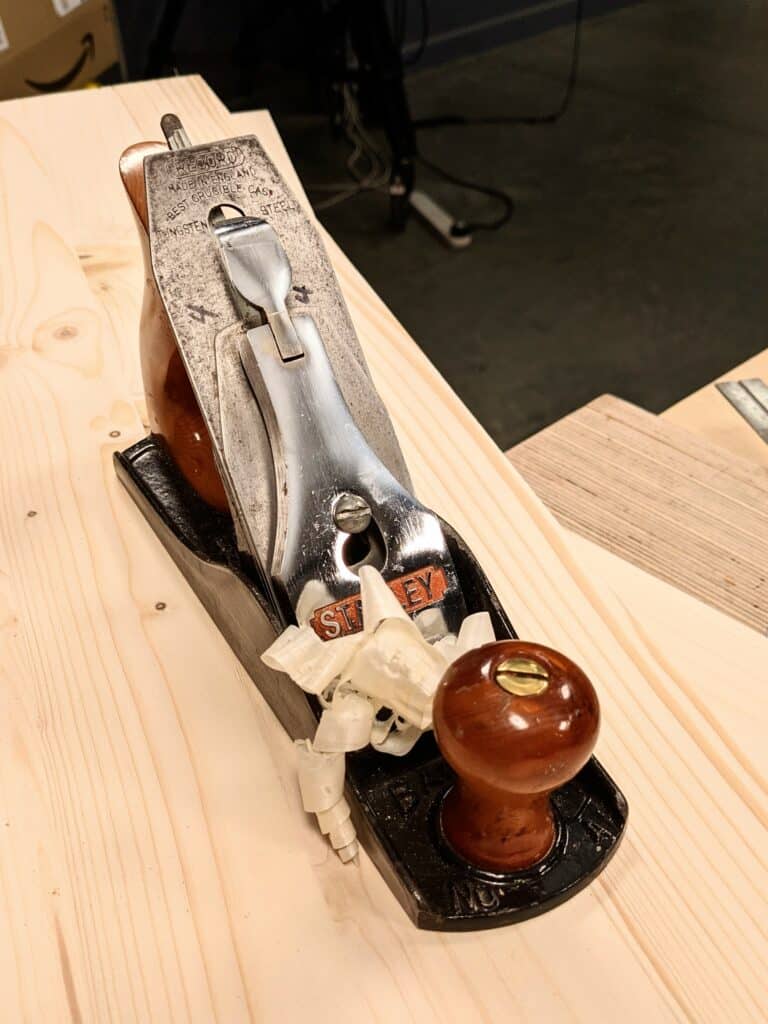
I used a hand full of planes, notably my favourite Stanely #4 smoothing plane, another #4 converted to a scrub plane, my #78 converted to a coarse scrub plane, a #5 and a #5 1/2 jack plane.
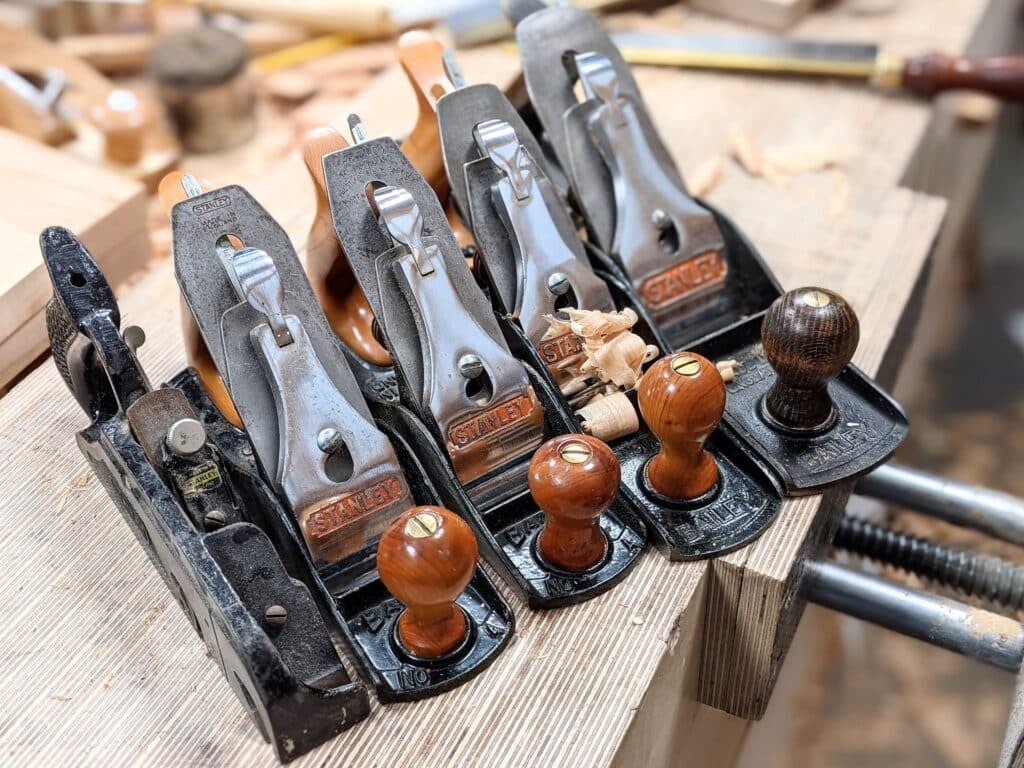
Now I should say here that I could manage perfectly well with a plain #4 smoothing plane for everything but having the others really helps to increase the ease of working and the efficiency of the various planing tasks. Technically, I would say that these other planes are non-essential but nice to have.
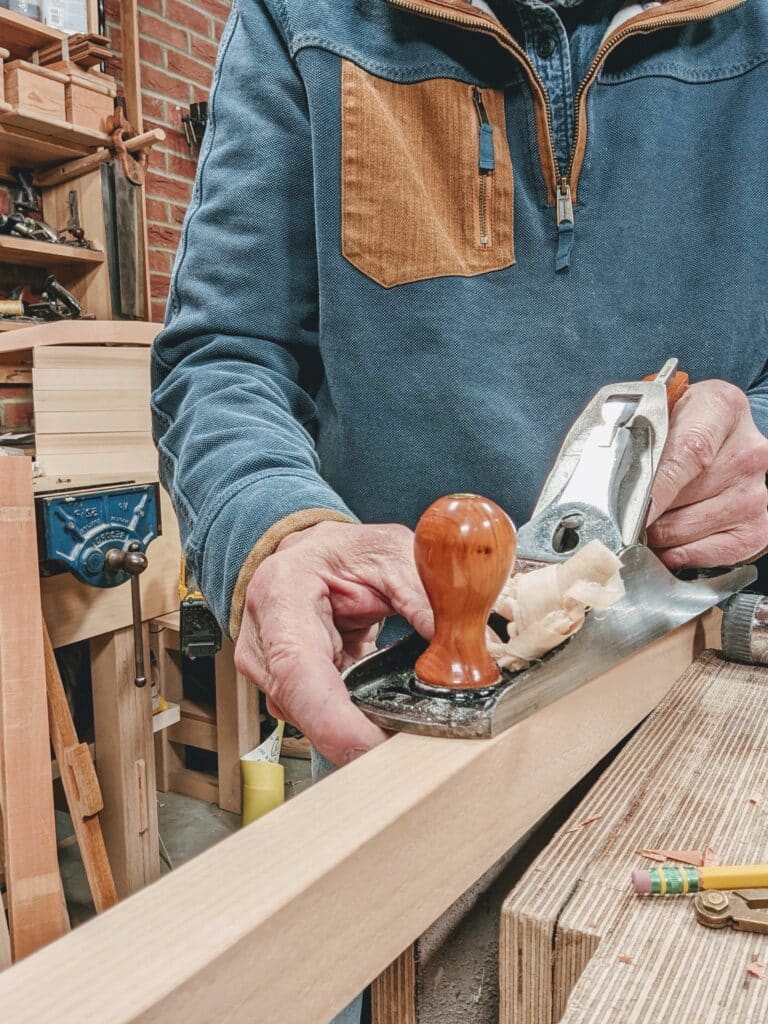
Router Plane
I created a problem and fixed it. My advocacy and use of the commercially made router pane caused the prices to increase by first two, three and fourfold but then they went up fifteenfold and the price became prohibitive along with a shortage of supply. Modern makers could not keep stocks in and so I went to the drawing board and designed my own version. Thankfully it surpassed the commercially made ones and it has become very popular with wonderful feedback. Over the years I have been able to show woodworkers how to use the plane for many tasks the makers never thought of. Surfacing tenons paraplanar to the rail face for one and then parallel to each for the other. It may not seem radical at first but it made the most amazing difference to every student I ever taught in class and eliminated twisted doors and frames were no longer misaligned. It’s an afternoon’s work to make one and we have a kit available with all of the metal parts including the hardened and tempered Sheffield-made cutting iron.
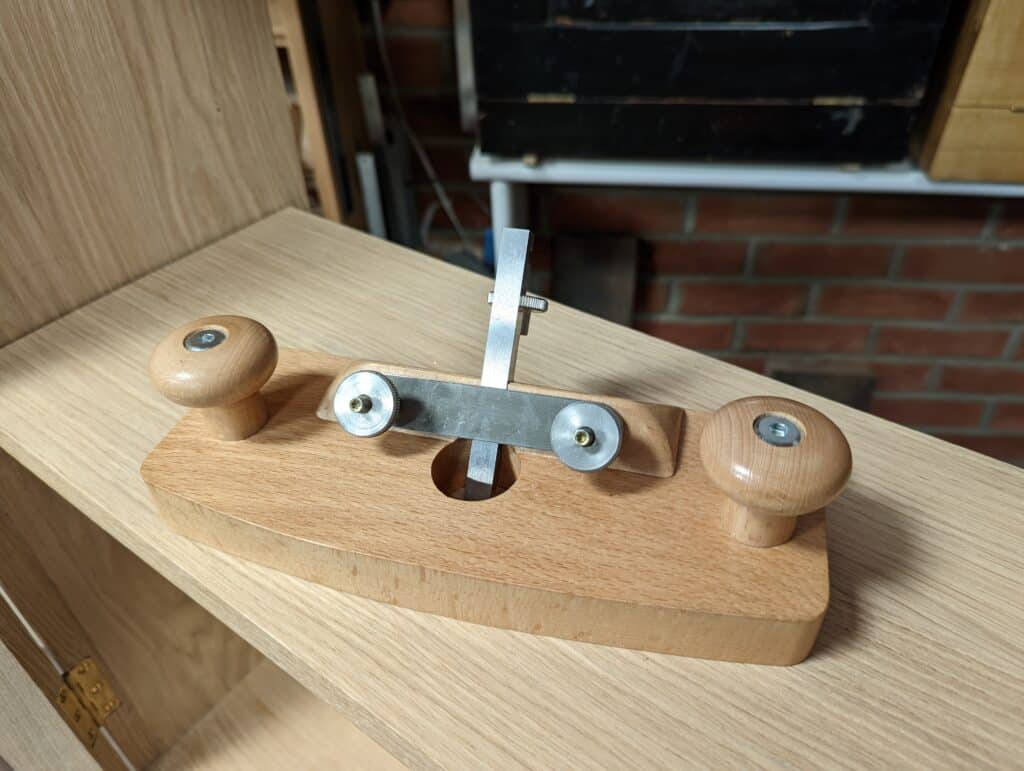
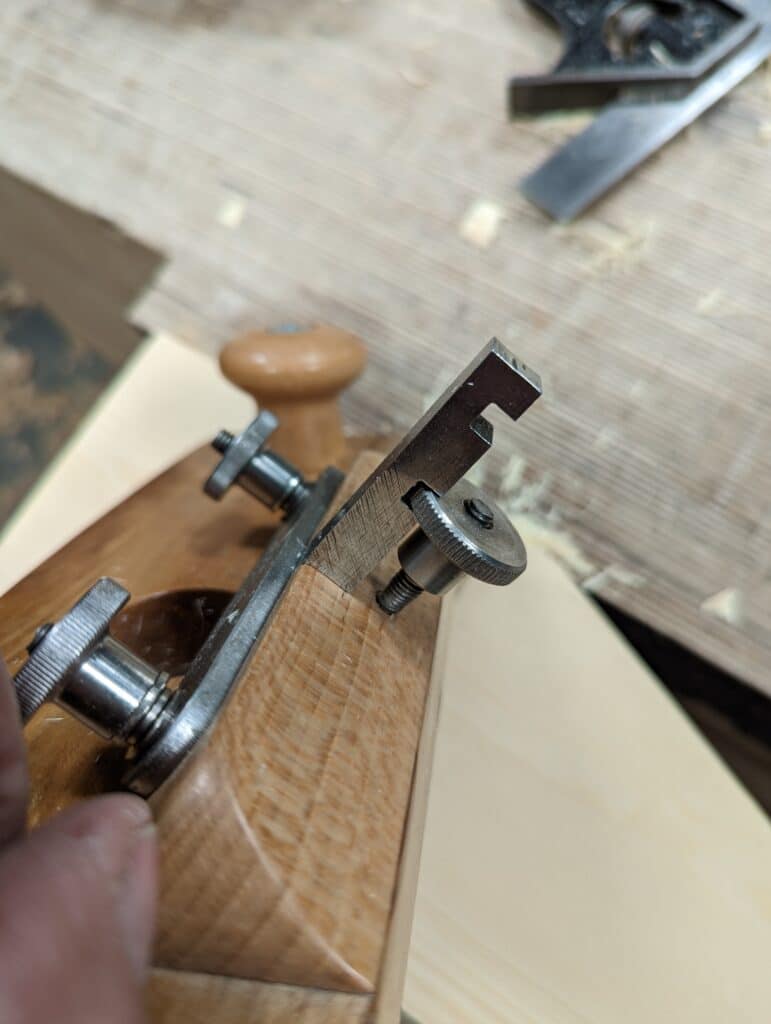
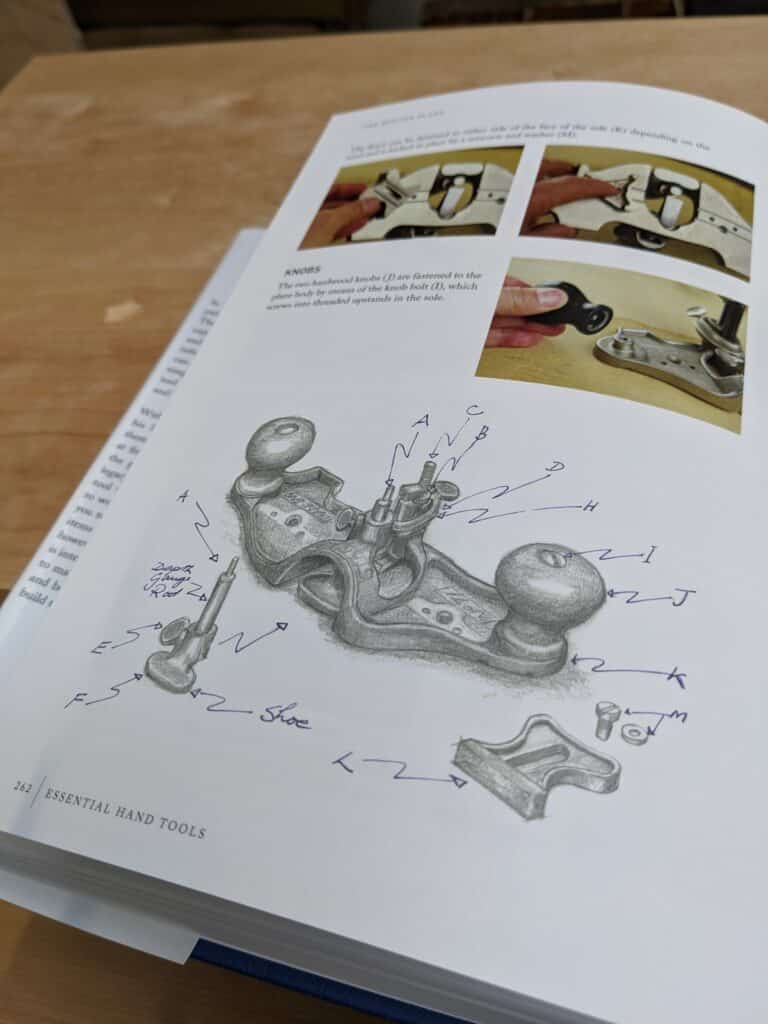
Plough plane
My other planes include a Record or Stanley plough planes Both Stanley and Record versions all work exceptionally well and are equal to one another in performance.
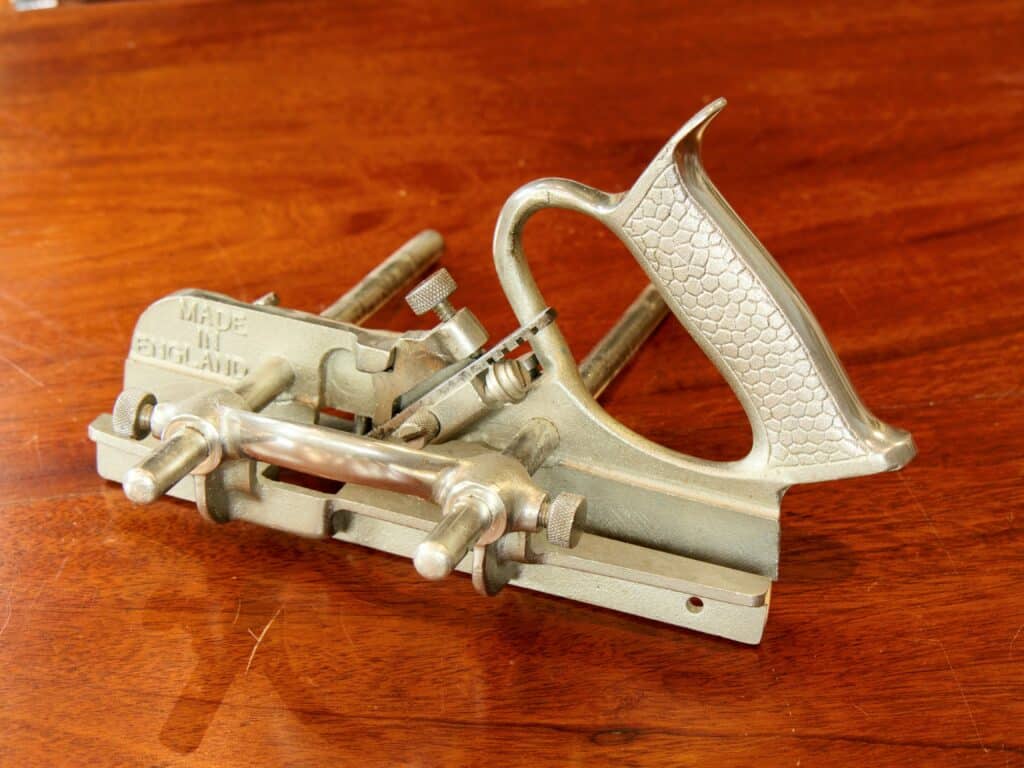
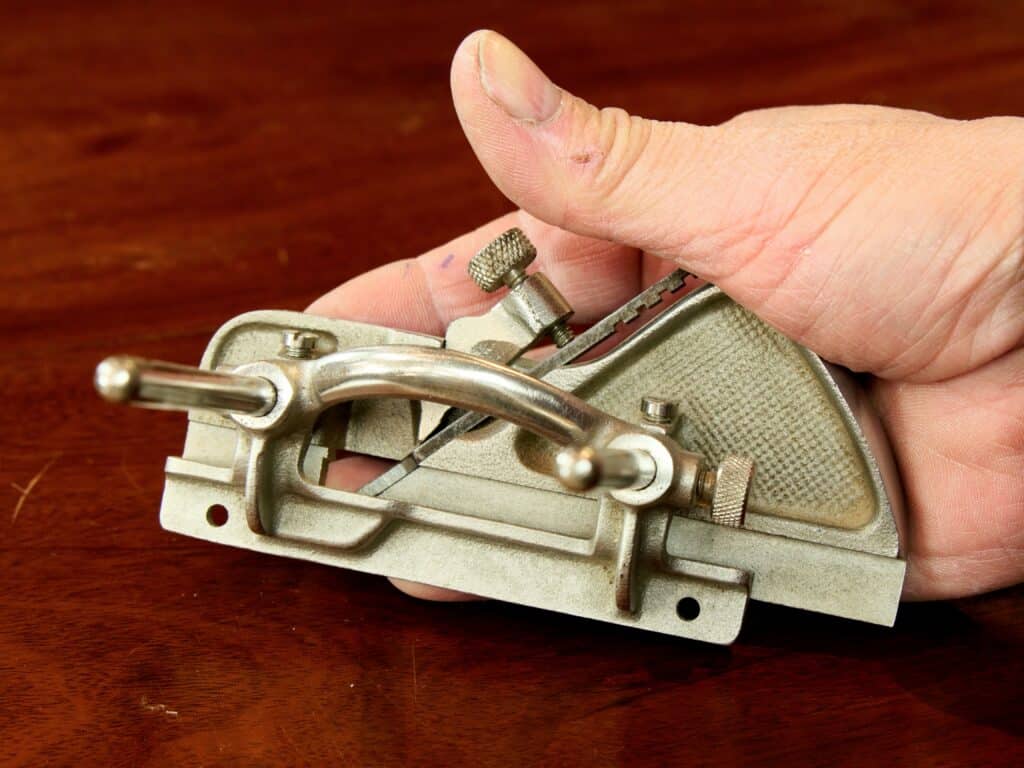
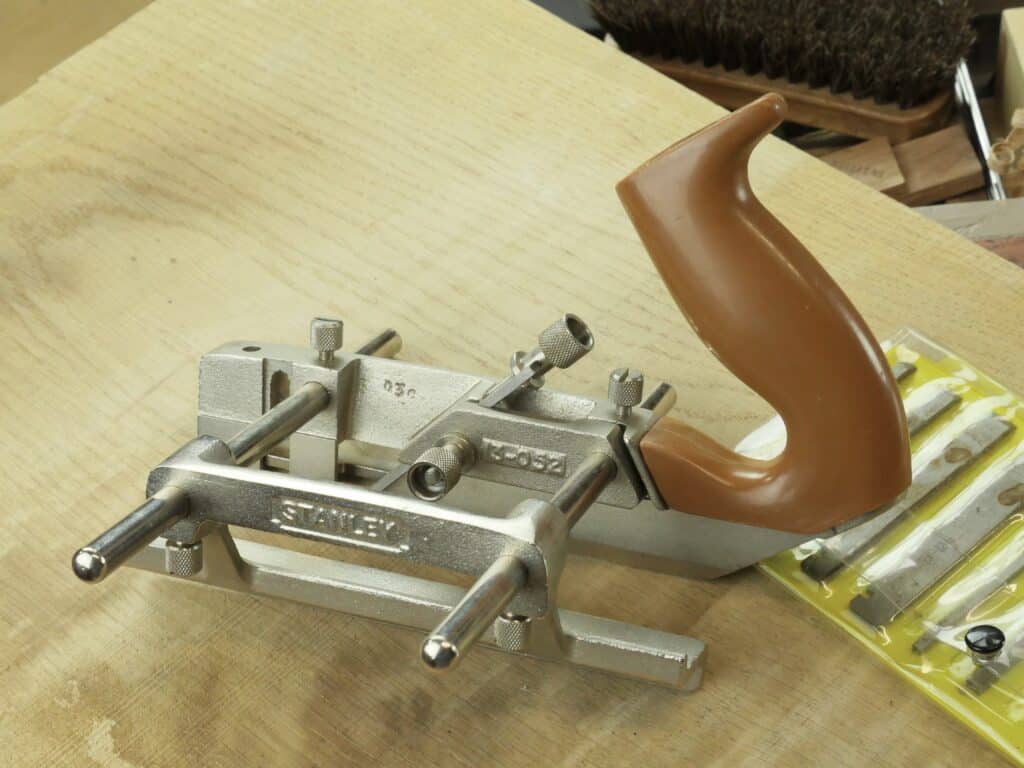
Rebate Plane
Though I use a #78 rebate plane as an excellent scrub plane, I also rely on one for treating all manner of things throughout my projects. It takes a while to fully understand the dynamics surrounding forming rebates because there are non-obvious idiosyncracies affecting the performance of the plane and these include the plane itself, the wood you are working and then of course your humanity. But they are really worth persevering with and my book goes into great detail for setting them up and using them.
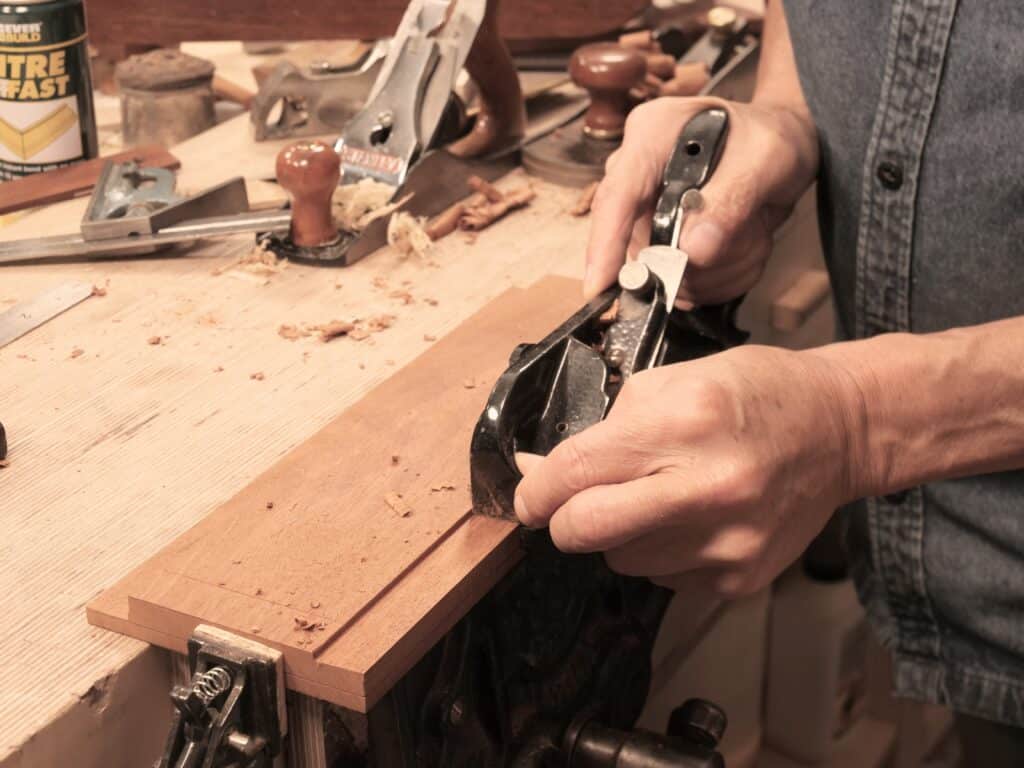
Cabinet scraper
The cabinet scraper is one of the most indispensable hand tools in the arsenal of tools for finishing wood. It takes care of any and all awkward grain.
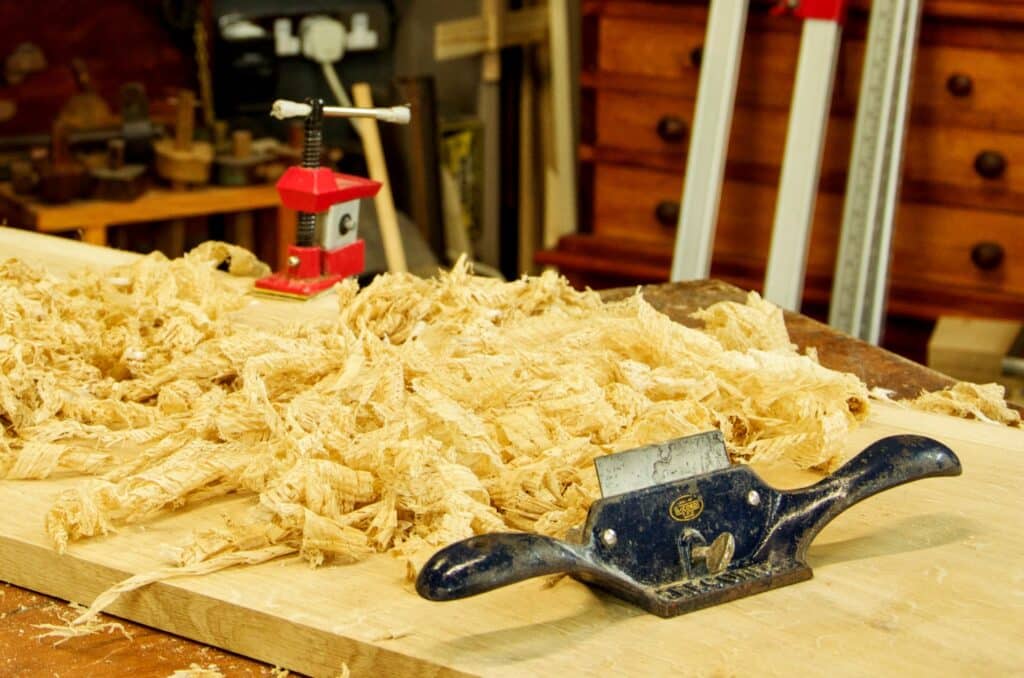
Card scraper
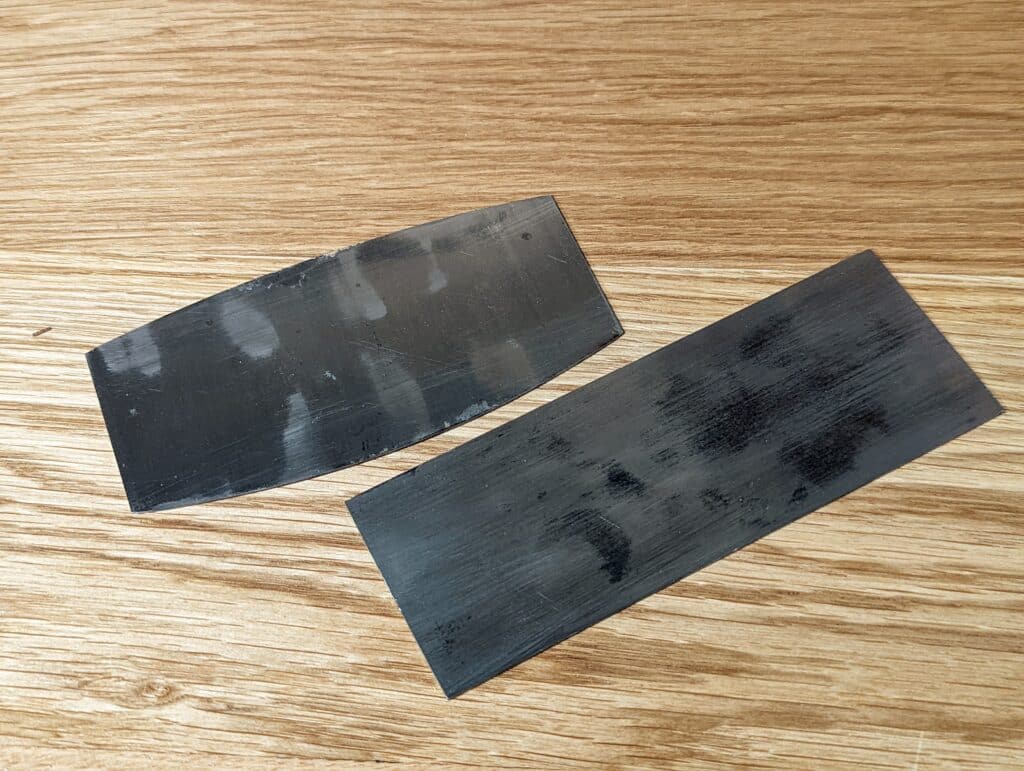
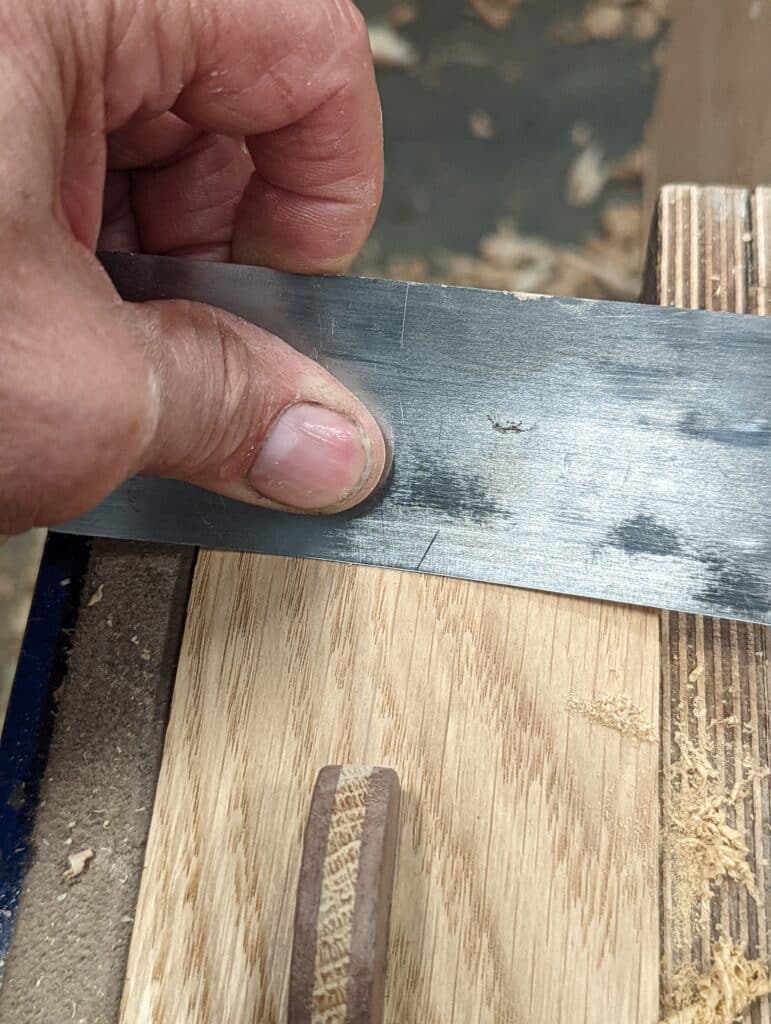
Card scrapers take up the slack for wherever a cabinet scraper just cannot or rarely works and that is in localised areas and on narrow edges or near to an inside corner. Basically, it is the most sophisticated of all cutting edges used in woodworking and for more information on creating this edge go to my video here for a quick lesson to see how this is done easily and efficiently.
Support equipment for planing work
Winding sticks
Funny thing to see woodworkers buy aluminium winding sticks when making your own from mixed woods seems to me so much a part of what we do. They are lifetime aids and absolutely essential for us to own and use for truing our wood. Join the 300,000 who have watched my video on making them here. You won’t regret it.
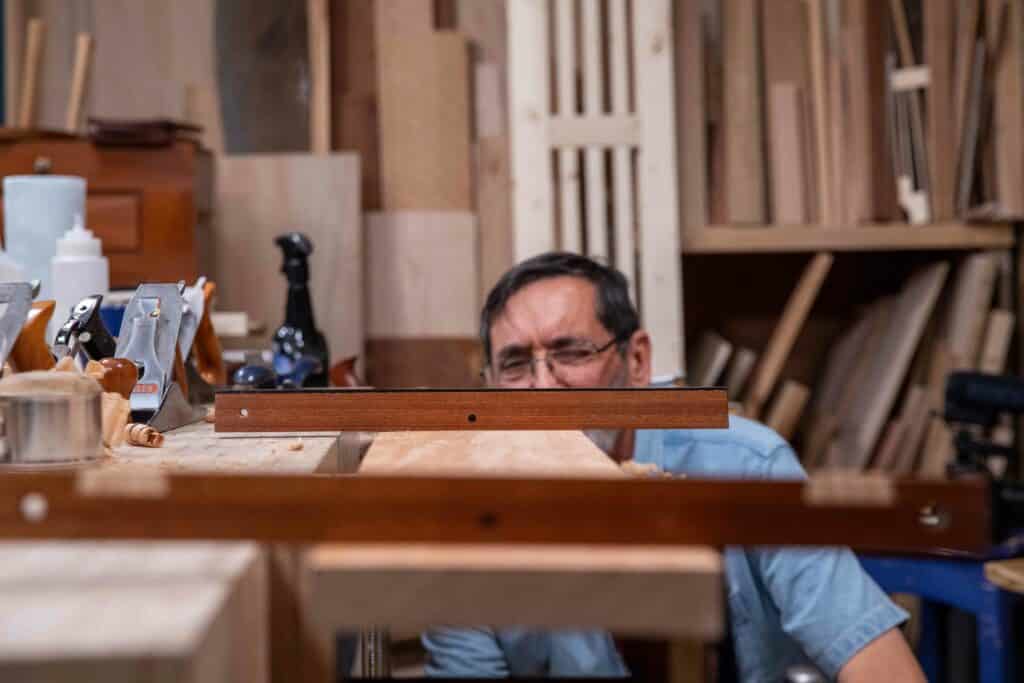

Straightedge (metal or wood)
Metal or wood, straightedges keep us in line when we are working on layout and such. They must be straight and you can buy commercially made ones in addition to making your own. A 24″ metal one is very good for checking straightness and wooden versions can be made for longer ones for almost nothing. To check for straightness when made, and correcting if needed, check against the edge of a piece of plywood. Plywood, a decent grade, is almost always dead straight.
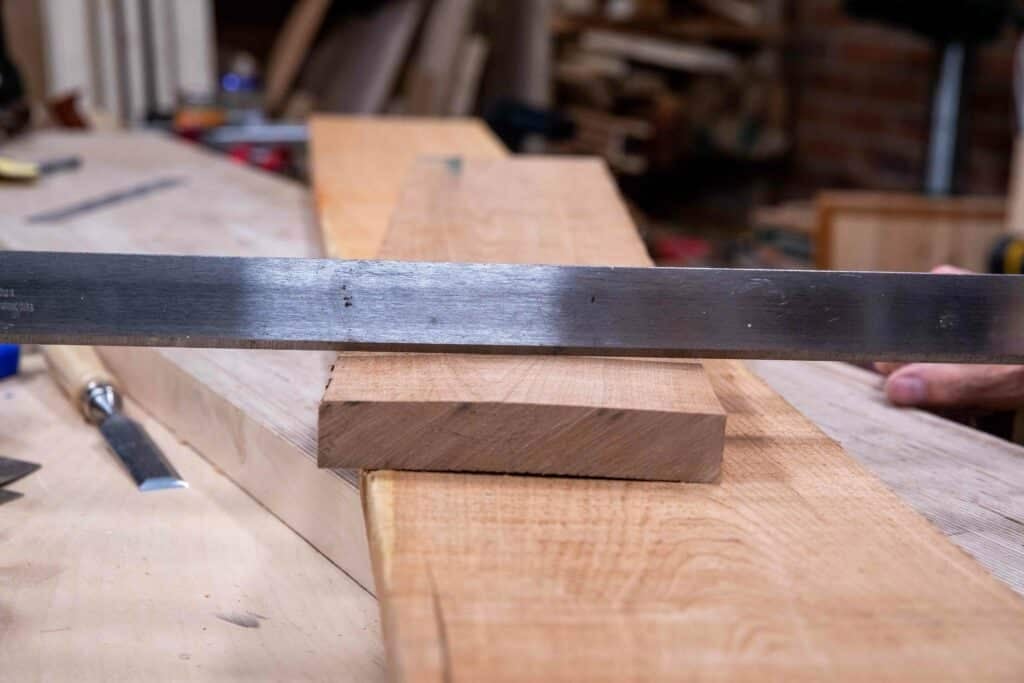
Layout Tools
Combination square 12″
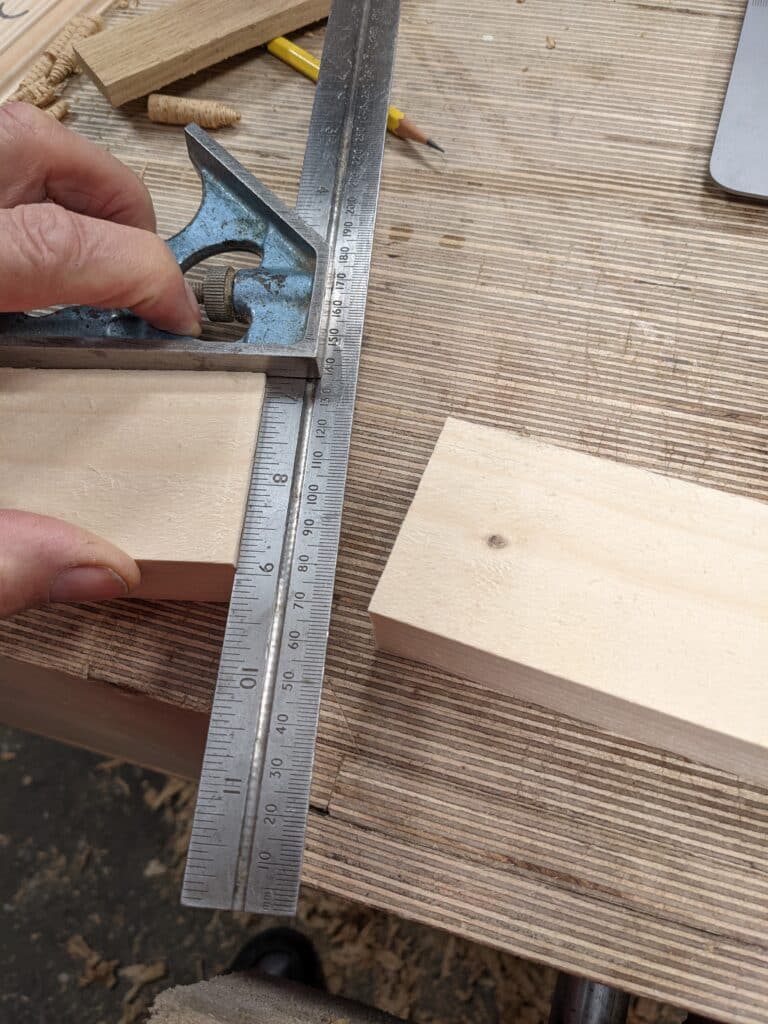
My favourite workhorse of a square is the combination square designed by an engineer for engineers almost a century ago. I have been using mine since 1965 and it is important to buy a good one as almost every single woodworking joint relies on the accuracy of your square. Not only that, almost every tool you use takes its reference and use from the square. Buy secondhand or new but look for excessive wear if buying secondhand.
A new version of this type of square is made by Stanley but must be checked for square as they often come out of square.
Stanley Folding Pocket Knife
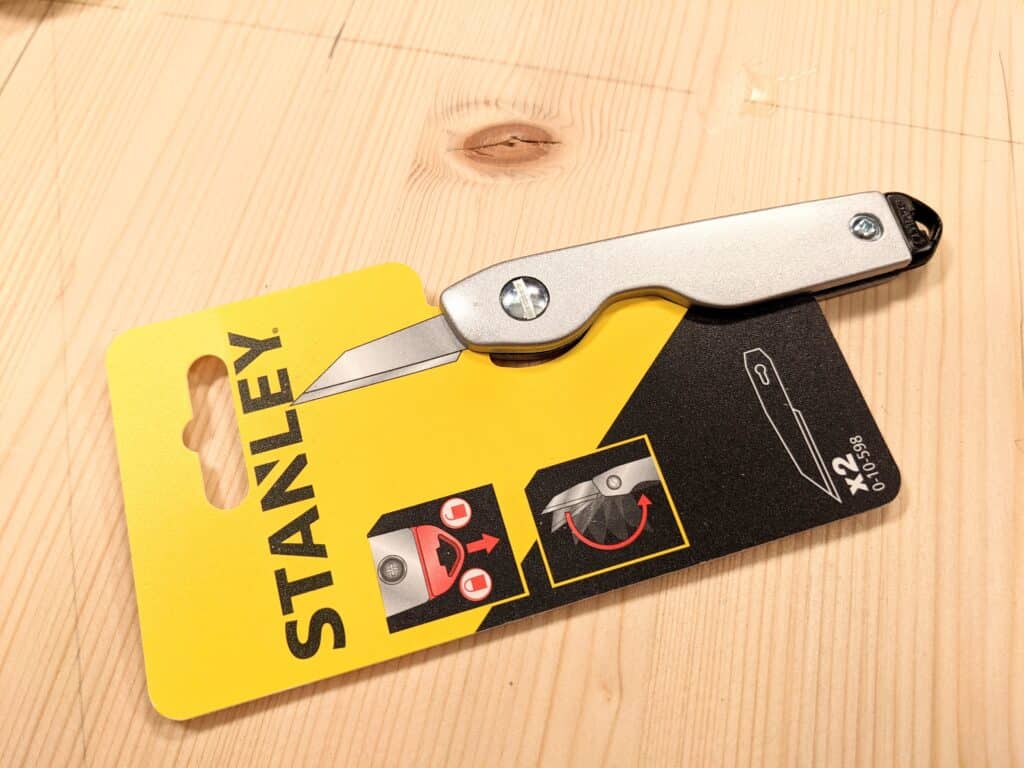
This has to be the very best layout knife for creating the knifewalls we depend on for perfect shoulder lines in joint making. I have never found a knife as versatile and the great thing is that it is resharpenable even though it takes replaceable blades too. The cost is the lowest ever too at just £6.50.
Marking Gauge
Marking gauges is a general term used for different marking gauges but we generally accept it as a single pin marking gauge like the first picture here. The combination gauges below that combine two gauges in one but it is good to have more than one gauge as we often use more than one at the same time in a project.
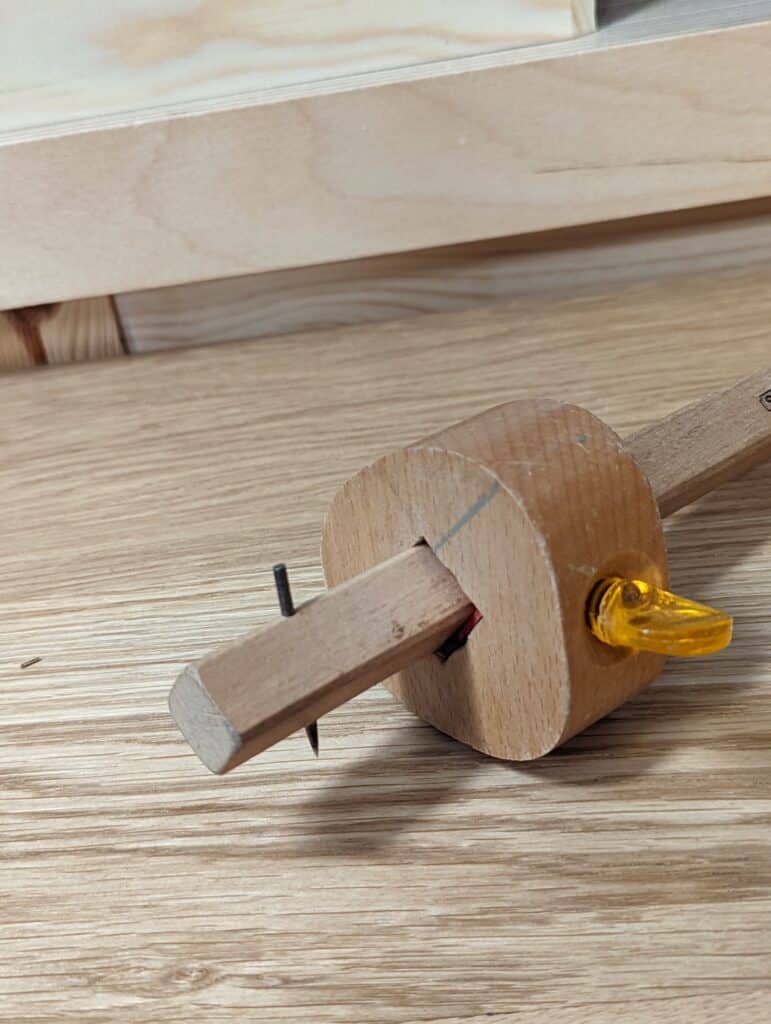
We use marking gauges for a wide range of tasks but always for marking lines parallel to the edge of a length of wood. It’s quick and simple to set and use. Acquire them secondhand when you see them. They usually go for a few pence secondhand or at garage sales. I will often have three or four set up for different marking distances in a single project and it saves resetting each time you move from one section of work to another.
Marking/Mortise Combination Gauge
These gauge types are used 90% of the time for laying out twin parallel mortise and tenons lines for cutting to.
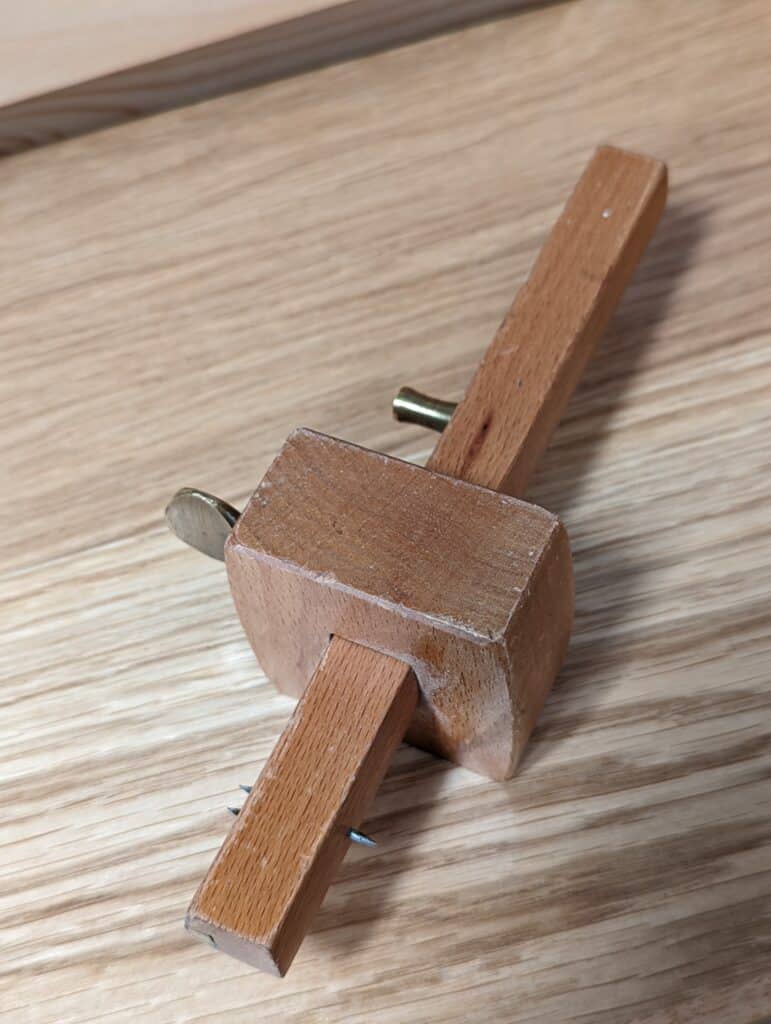
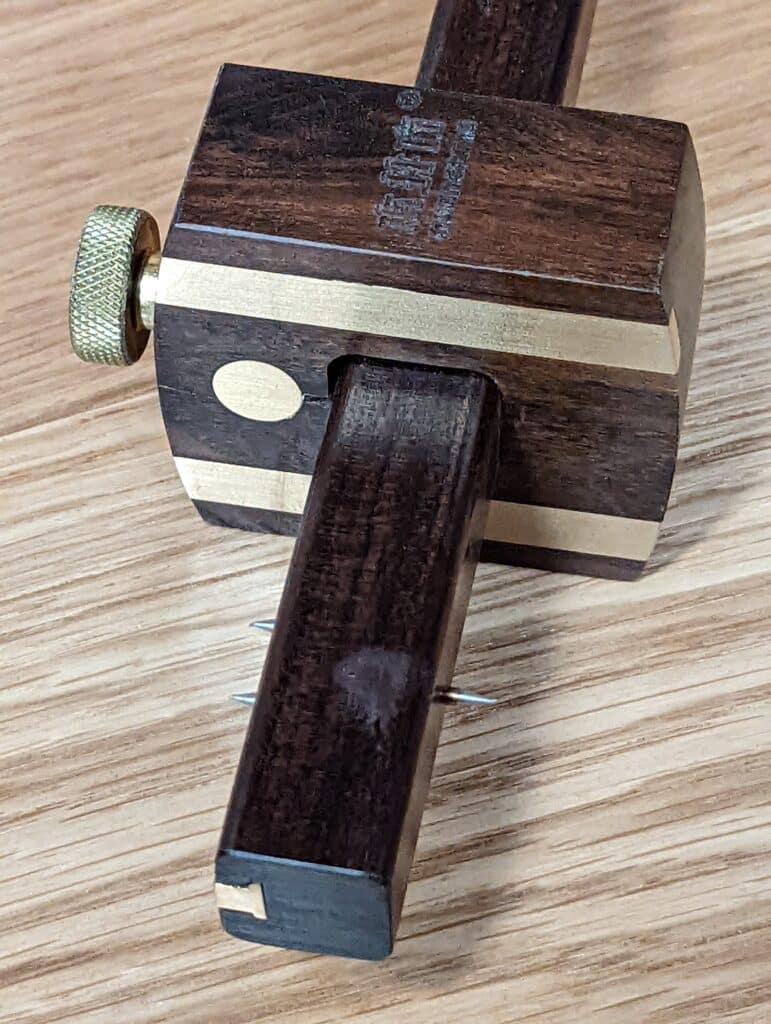
Pencil
Almost any pencil will do but softer ones crumble too easily. I use an HB (#2 USA) for general daily use on wood as well as initial sketching, technical drawing and such. Serious drawing takes several pencils.
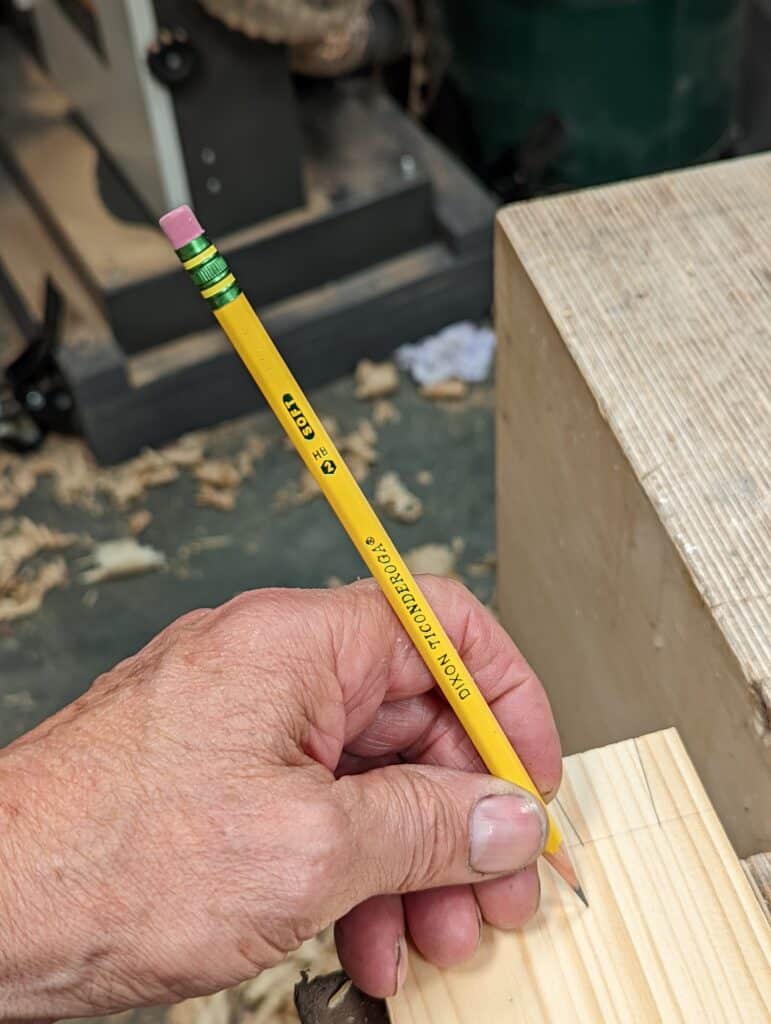
Dovetail Template
I have used this dovetail template for over half a century and it never wears out. It’s quick to have one in your drawer ready to go so a timesaver making your own. Here is a link for you to make your own.

Sliding bevel
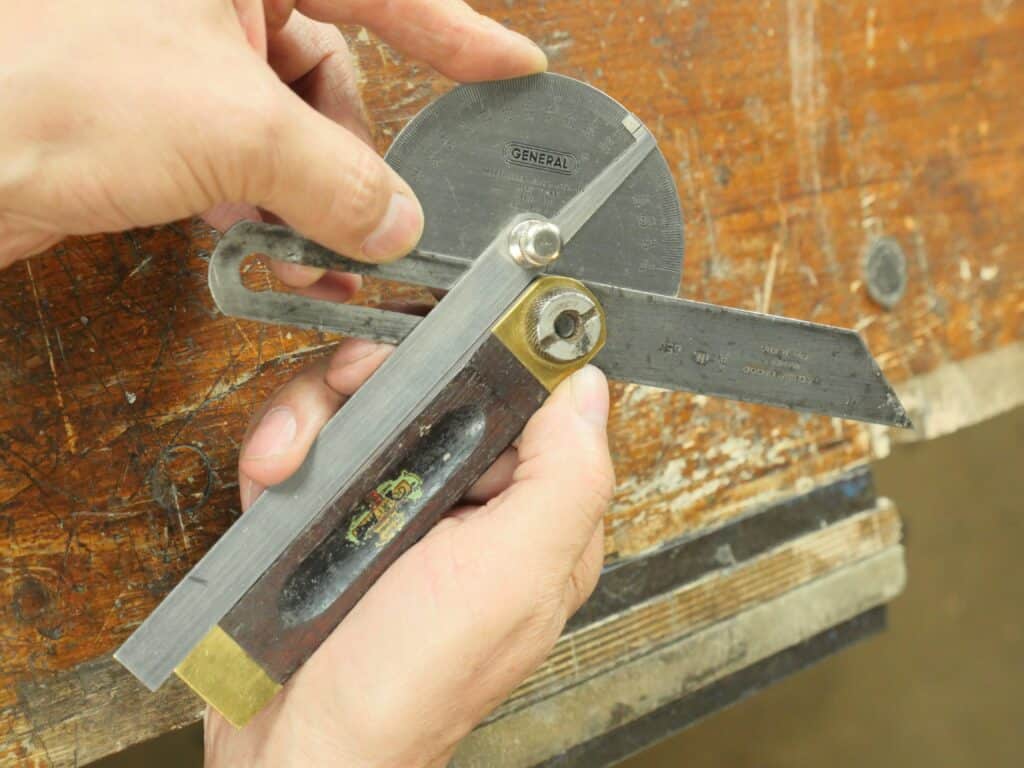
The sliding bevel is the tool we use to transfer angles from a protractor to a workpiece or to check the angle of a workpiece to find the exact degree. We also register it against a sawn or planed edge cut to an angle to test for accuracy. I usually have two or three because things like chair making may have several angles to work to and having them set keeps the accuracy we strive for and saves resetting mid-project.
Protractor/Angle finder
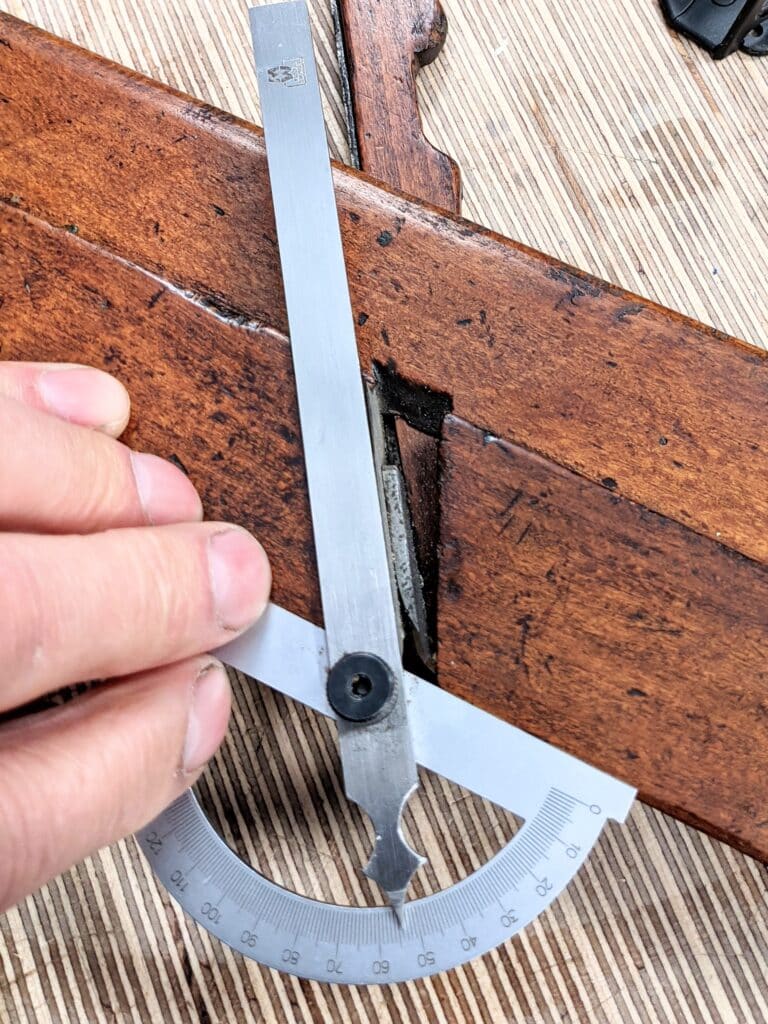
Compasses
My vintage pair has served me well through the decades but there are some well-made modern versions that are great too. The one with a winder adjuster (right) is highly controllable and easy to ‘dial in‘ the exact setting that keeps the compasses set.
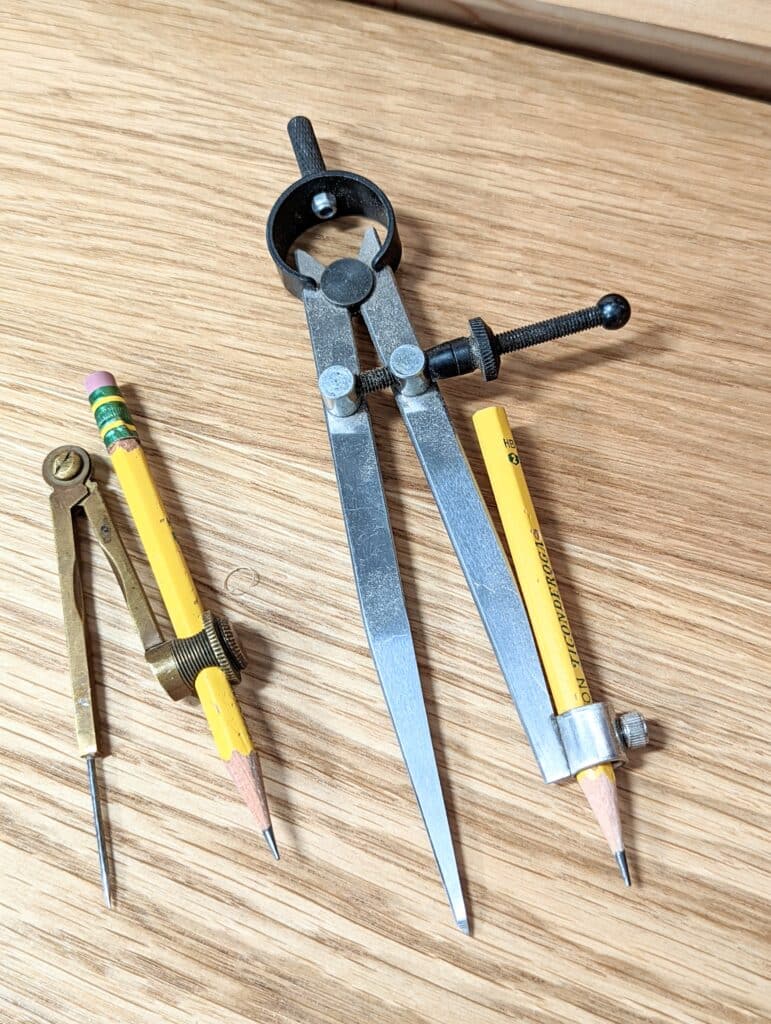
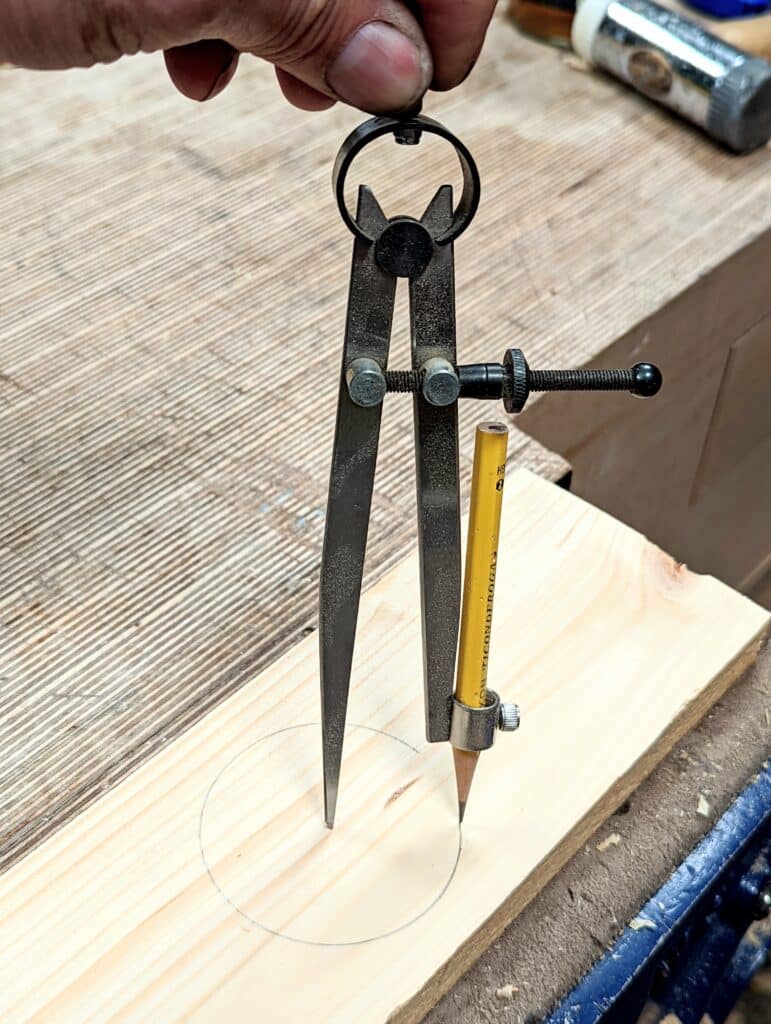
Tape measure
Many may contradict me but there isn’t really too much to say about a tape measure. As it is very rare that any piece we make as furniture is longer than eight feet, a ten-foot tape is plenty long enough and can be had as lightweight items in your pocket. I have the least expensive plastic ones that are accurate and compact. I carry one in my pocket I bought for its size and then several (five) of the blue ones shown to identify as mine and I can leave them around the workshop and never have to go in search of one. I need one when I am out and about as my whole life revolves around measurements and angles and with a tape measure I can deal with both by developing a formula as I go. Oh, and make sure you have both metric and imperial in a single tape. If you are not used to converting in your head, especially here in the UK where both measurements are still being used, it can be a nuisance trying to work things out.
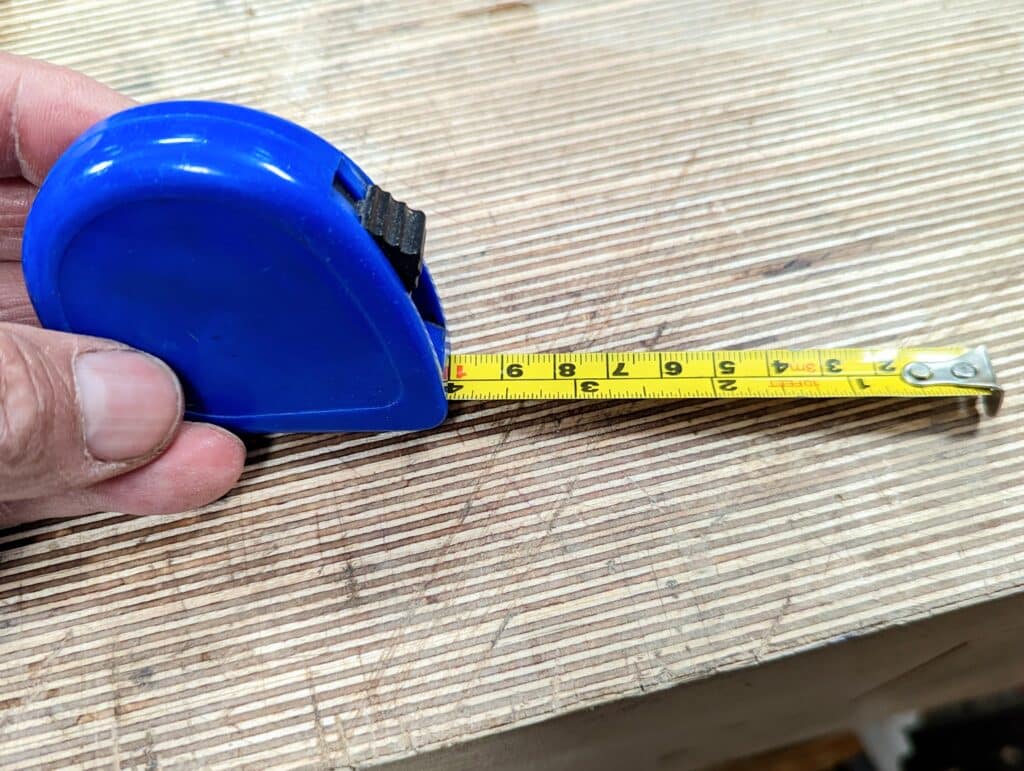
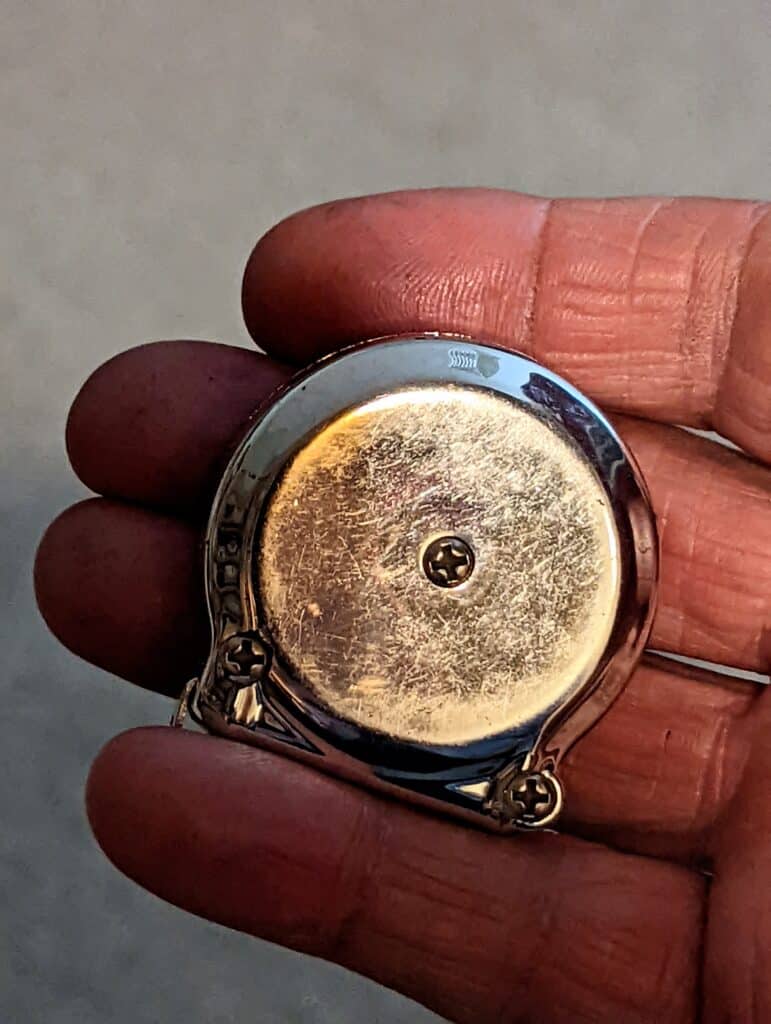
Steel rule
My steel rule is more a vintage version by a good and well-known maker and has imperial measurements one side and metric the other. It’s fine but sometimes I prefer both to be on one side so I have a second one for that reason. The better quality ones are hardened and tempered and they hold up better than the stainless steel only ones, but they work well enough too.
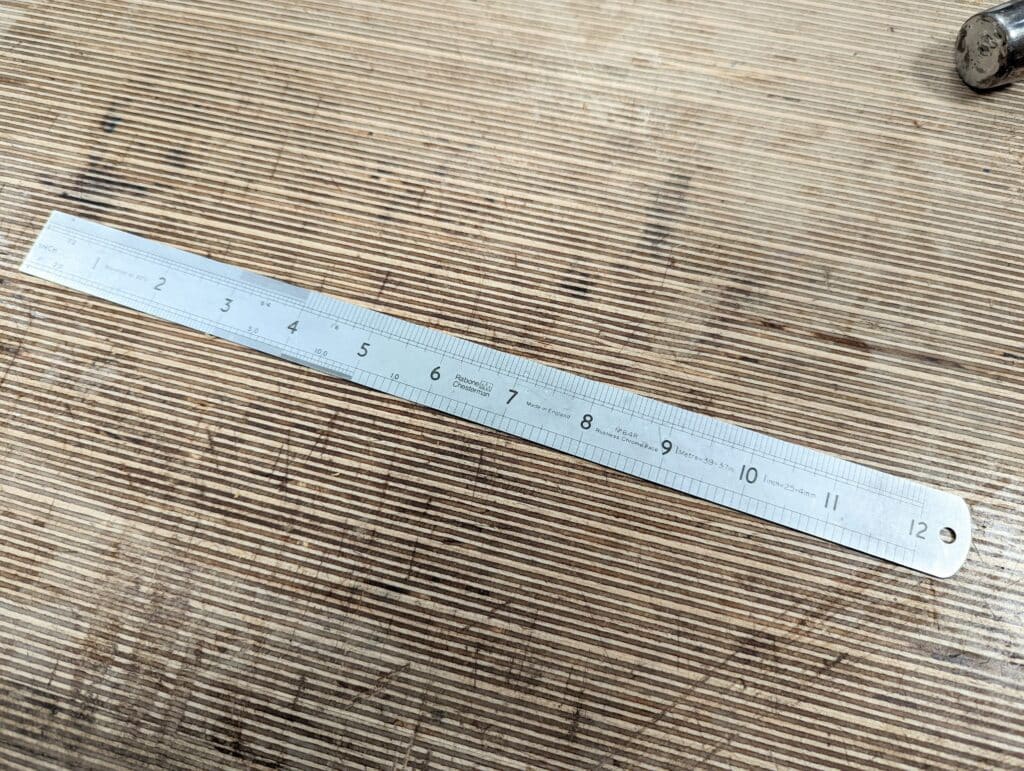
Vernier Calipre
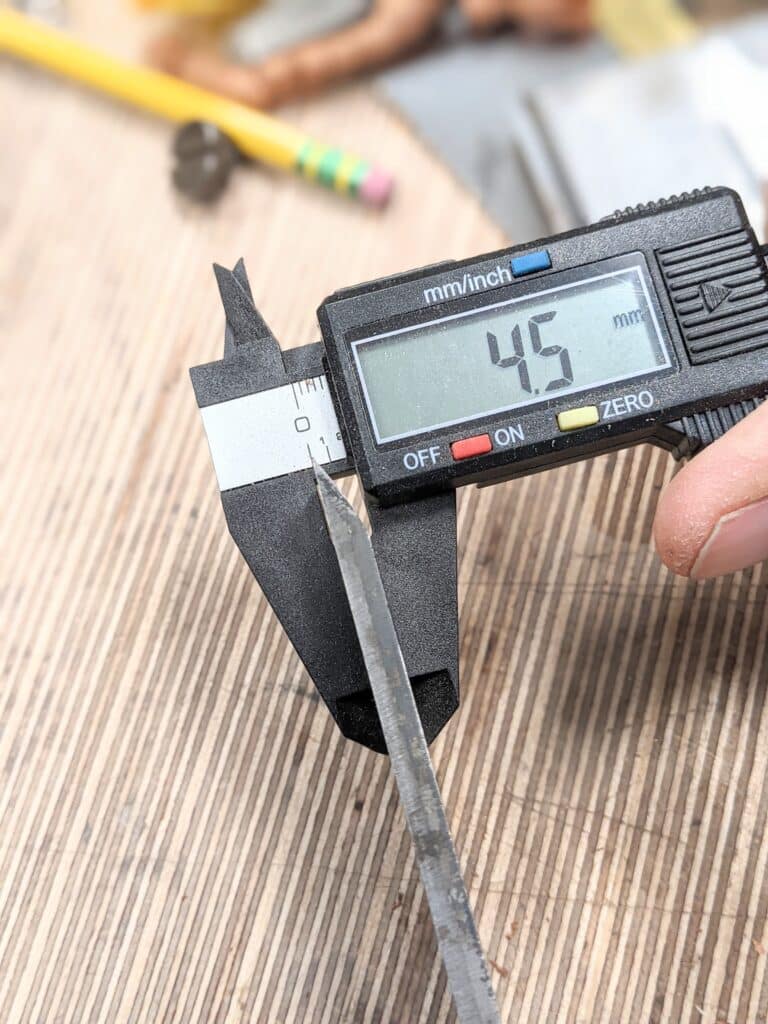
I never used one for the first two decades of my woodworking life and then began using one and now I cannot live without one. I use it all the time to check my planing accuracy in thicknessing particularly. Much of woodworking is about fitting and how better to check q tenon thickness than with a vernier. Woodworking often involved metalworking too, so again, I use mine extensively.
Hammers
Chisel hammer
As an influencer, I have done more for this company than any user in the world. Why? Quite simply it’s the best there is and I have used one for a long time. I did at one time advocate only wooden mallets and I still own one but this hammer satisfies me the most because I have zero wasted energy with it and it delivers the COP (centre of percussion or ‘sweet spot‘) right on.
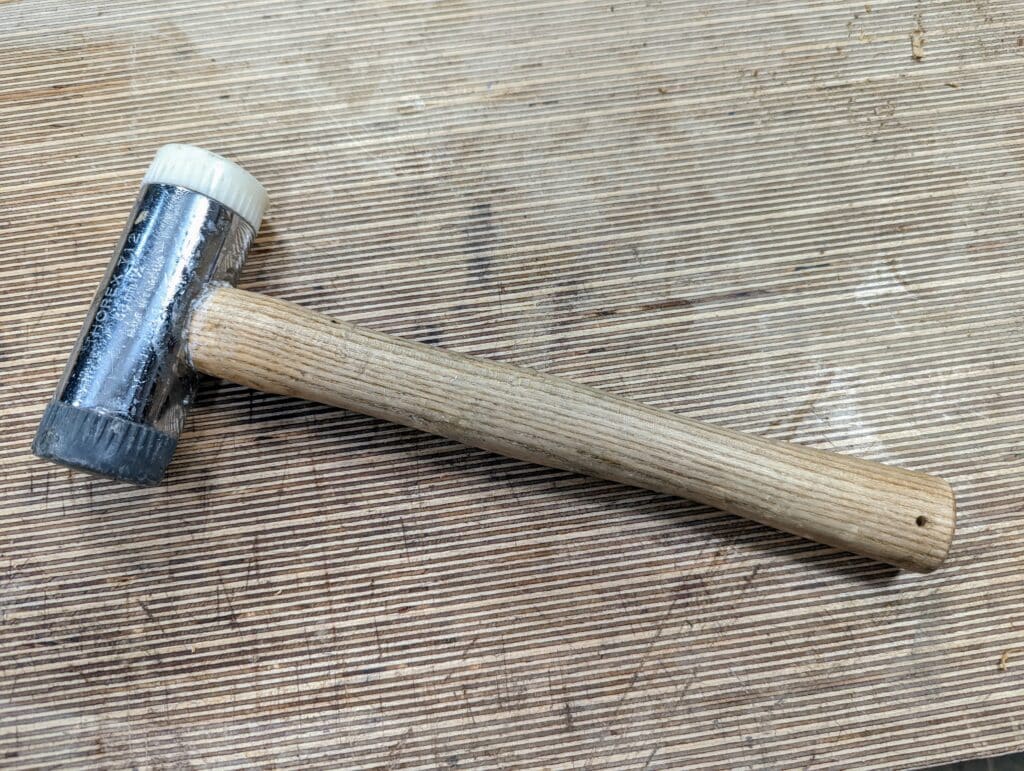
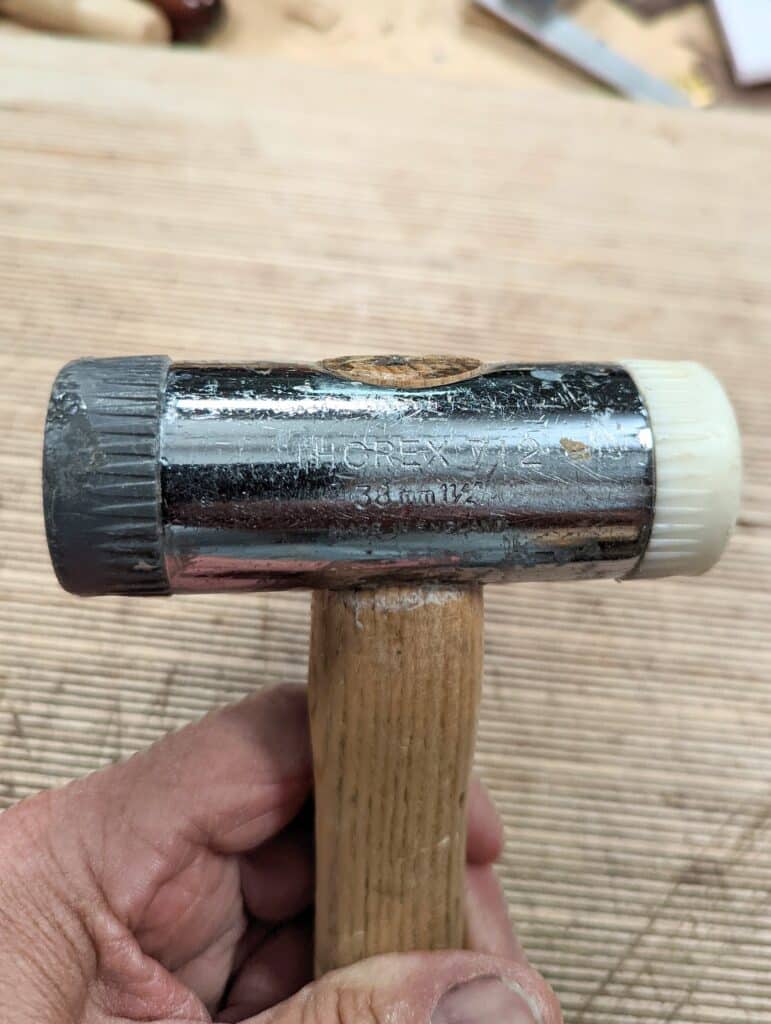
Warrington hammer
I use a couple of sizes of Warrington cross peins. 10oz and 12oz. For driving small nails and many other bench tasks they are perfectly balanced with enough weight and the cross pein comes in so useful for many tasks not the least of which is driving very small brads.
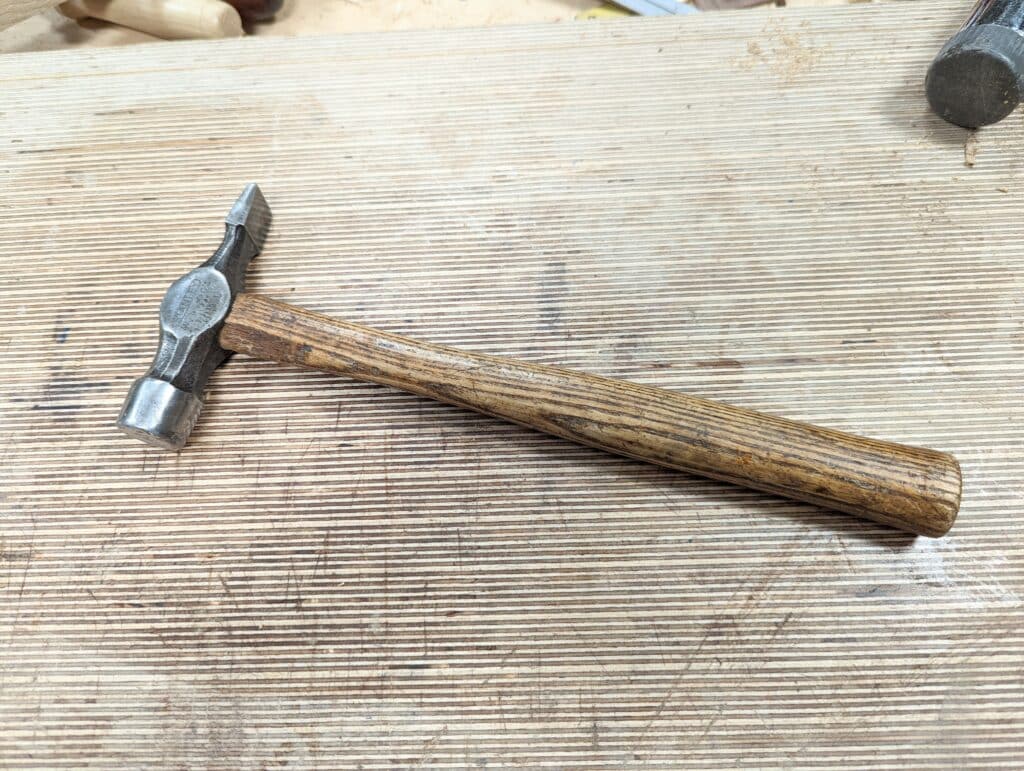
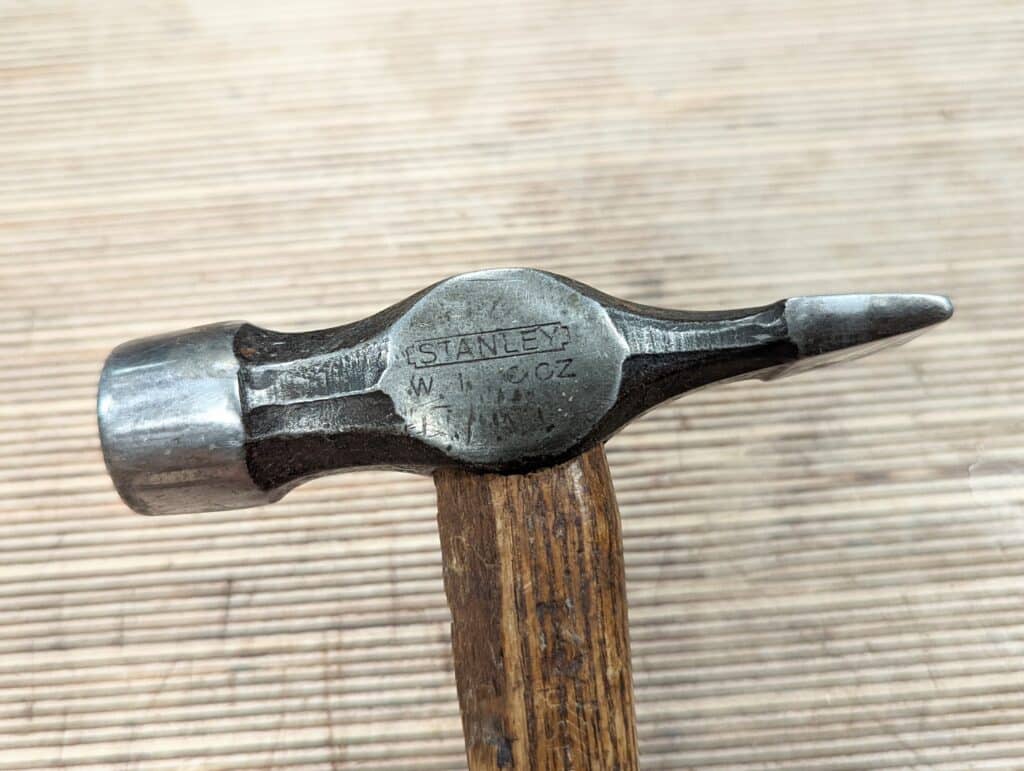
Brace and bits
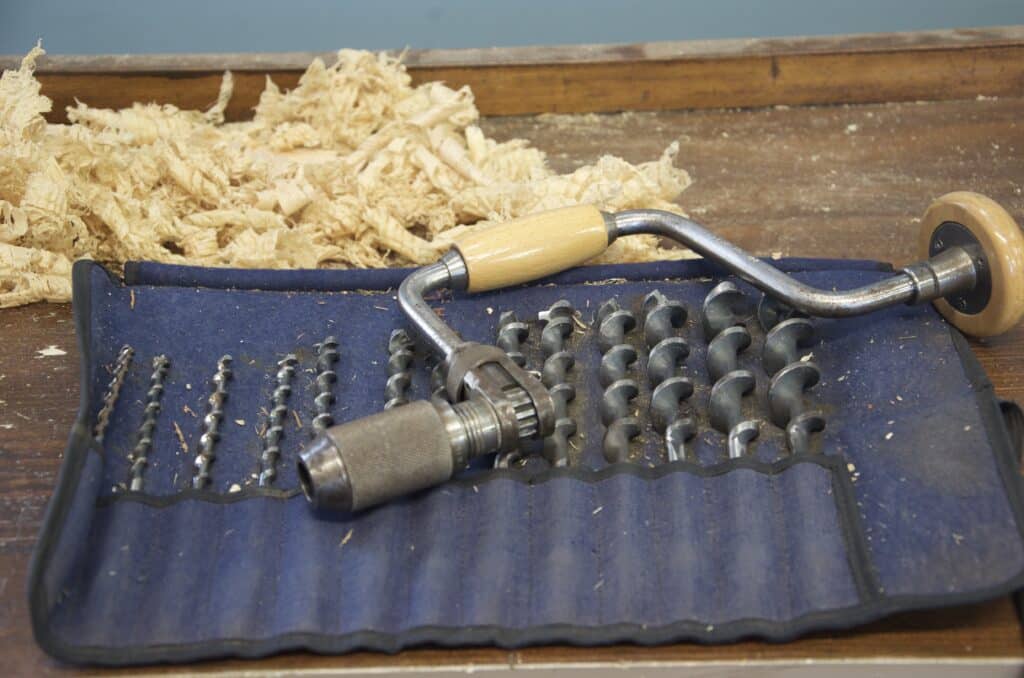
Swing or hand braces, often called bit braces, sell for almost nothing these days and that is simply because the ubiquitous drill drivers have replaced them. When a high torque with a slow and controlled speed is needed these tools are fit for purpose. The bits as shown too can be had as a set (vintage only nowadays) or bought individually which will cost you much less. the bits can be sharpened like chisel edges with general saw files and narrow diamond hones. If you take care of them and never hit nails or screws they will last for a lifetime of woodworking.
Twist drills
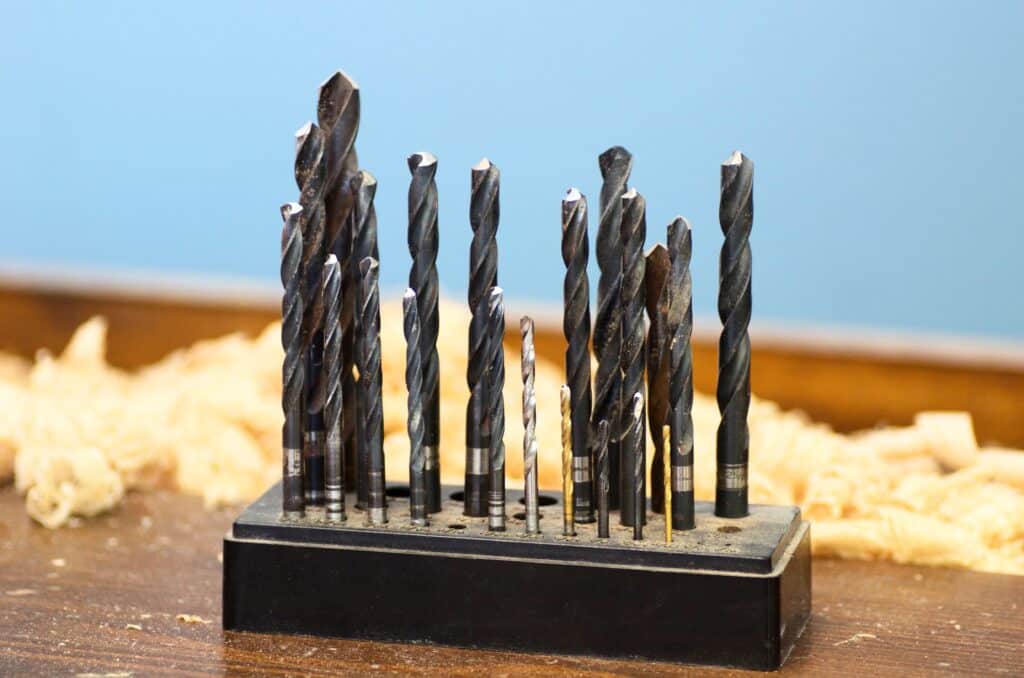
Twist drills come in every size and a set will cost very little considered the lifetime use they give. metalworking twist drills will drill all materials including most metals, wood and plastic. They are resharpenable on a grinding wheel or with special bit sharpeners but I just eyeball sharpening with a grinding wheel, always have. The nice thing about that is I can go for a more resistant bevel for cutting metals of all kinds or a more aggressive cut for high speed in wood.
Paddle Bits
Paddle bits are not made for use with a hand (swing) brace as they rely on high speed to cut efficiently. Thankfully, they are resharpenable and need it from time to time for a clean cut. These bits are not too sophisticated and that is what makes them very easy to sharpen with just a flat file. They rely on shear-cutting both along the sides of the bit that establish the walls of the hole and then the actual cutting faces either side of the spear point. In other words, unlike the augre bits, twist drill bits and Forstner bits, which all have raker cutting faces and side cutters for the walls of the holes, these bits have no such cutting edges but high speed helps them to more ‘scrape‘ the wood for deepening penetration.

Chisels
You don’t really need much by way of chisels. Bevel-edged chisels really are the best for the widest range of tasks including mortising, paring and chopping for dovetails, trimming, recessing and much more. In fact, I cannot see anything that other chisel types do that these chisels shown below don’t do equally well. I use a simple set of five basic bevel-edged chisels in the everyday of my working wood. I do not keep special chisels for the finer work. These do it all. There is really no need to pay more than £10-15 per chisel but you can get some sets for much less than that. People will tell you that thin-edge, refined chisels with super-thin sides are necessary for fine work like dovetailing but that’s not the case and not true at all. I think that the main reason for thinner-edged versions is that they just look nice and thereby seem better balanced and that’s as good a reason as any of you want to spend more. I will also say that when something looks nice and feels refined you might feel better about your work and your working so that is good enough. Most joiners I knew and worked alongside cut perfect dovetails for fifty years with square-edged firmer chisels with no issues. We’ve become more and more spoiled and of course, engineers have to keep inventing problems so that they can offer a solution with something more that they want to sell but there was no problem to start with. Take the thick-ironed clunkily-heavy plane to dispel plane-iron chatter as an example and then too the Bed Rock frog in planes to set your plane without taking out the cutting iron assembly. What not one of them tells you is that when you adjust the Bed Rock frog, which you need to do once in a few years possibly, you actually change the depth of cut automatically but there is no way of knowing by how much. Go ahead, try it! You adjust the frog to close up the throat for that really awkward grain and then you tear out the grain because you increased the depth of cut and ruined what you were trying to fix in the first place.
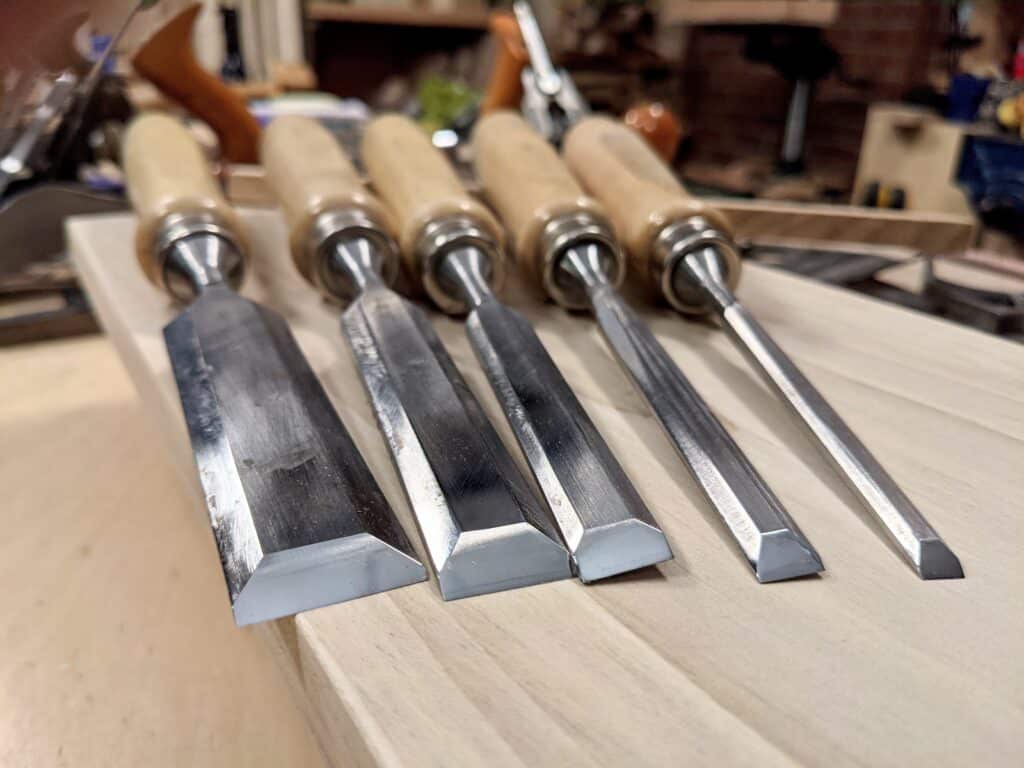
Rasp and File
Basically, I rely on the two below but I have others too. These work very well for 90% of all I do and the rasp saw has both coarse and fine they both remove material very efficiently with the fine side giving a very acceptable surface ready for filing or and sanding. Both last a long time, several years, when used on wood be that hardwood or softwood. It’s available in large and small versions which simply put is 11″ and 9″ and Amazon pricing seems to be between £20 and £24 respectively. The Bahco 10″ code identifier is 4-138-10-1-0 Mill saw or a 4-143-10-1 File 10in and costs around £10-14 but as long as you use files carefully and do not use them on overtly hardened metals they will last you for many years and on wood, you will scarcely wear them out at all.
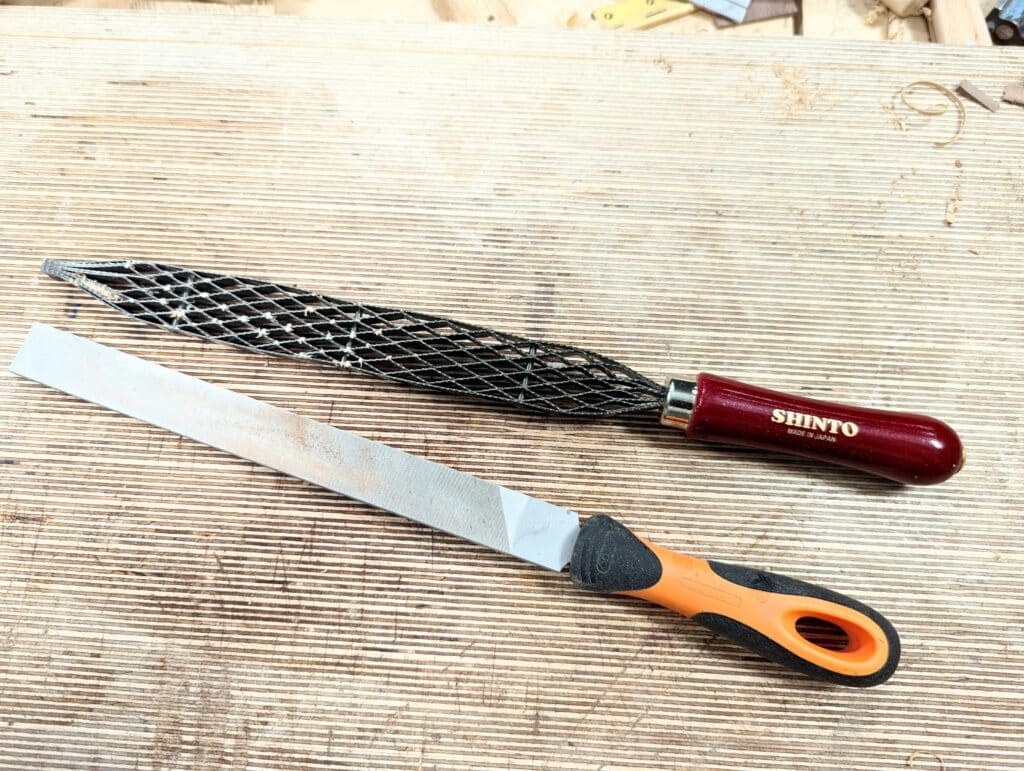
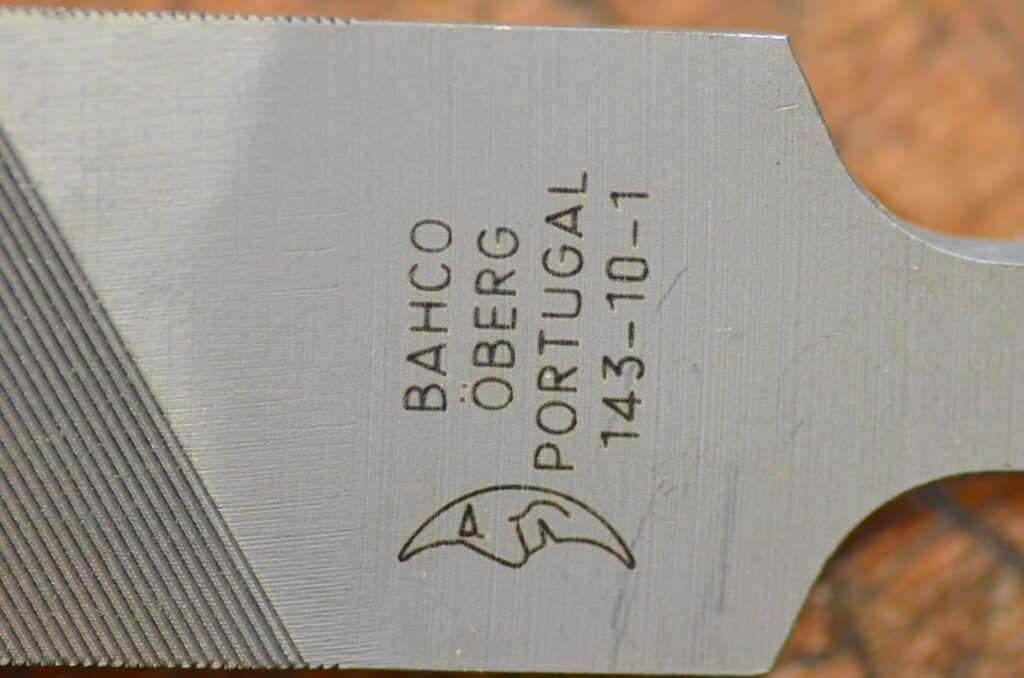
Saws
Handsaws
I have used a few handsaws on the projects but mostly I rely on my 22″ panel saw for crosscutting and 24″ panel saw for ripcutting. I can recommend the Spearb & Jackson versions new online via Amazon sellers. I have paid as little as £13 but generally, they go for around £22. They are a lifetime saw newly made for and by S&J. The only modification I have made has been to reshape the handle and that is a preference not at all a necessity. You can see the changes I made below. It takes me an hour to do this.. My panel saw has 10 points to the inch (PPI) and this saw will do most sawing for where larger effort is needed as in cutting panels and cross cutting boards and sections of solid wood A 24″ version works well for rip cutting and has 7PPI.
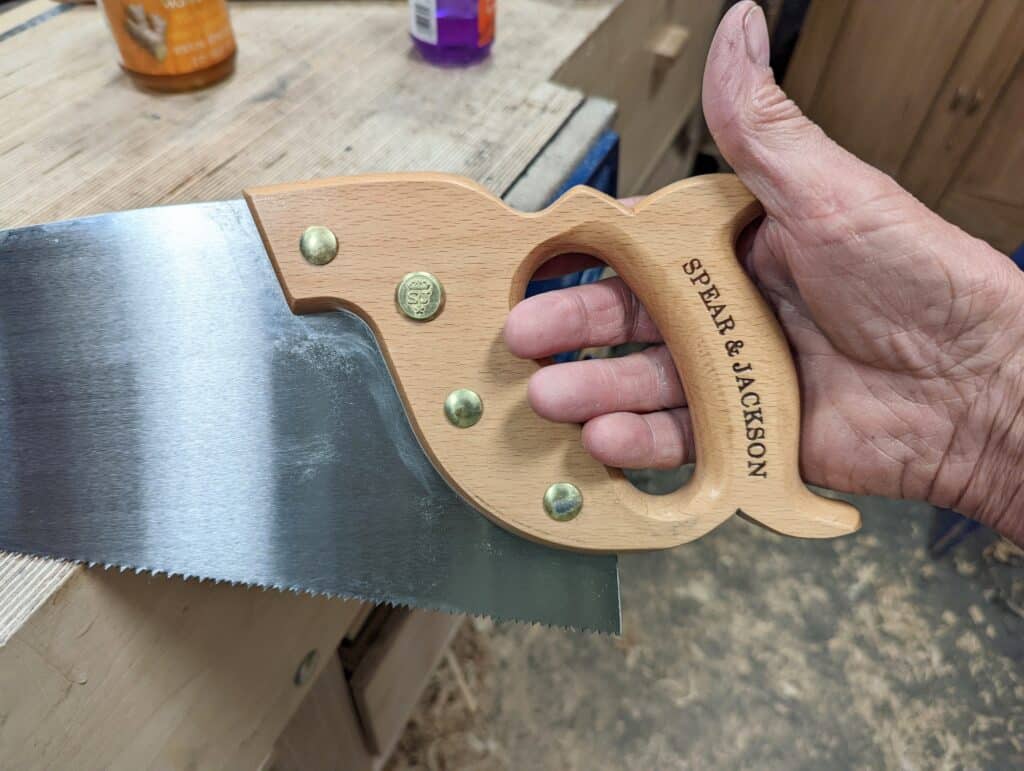
Tenon or Back Saws
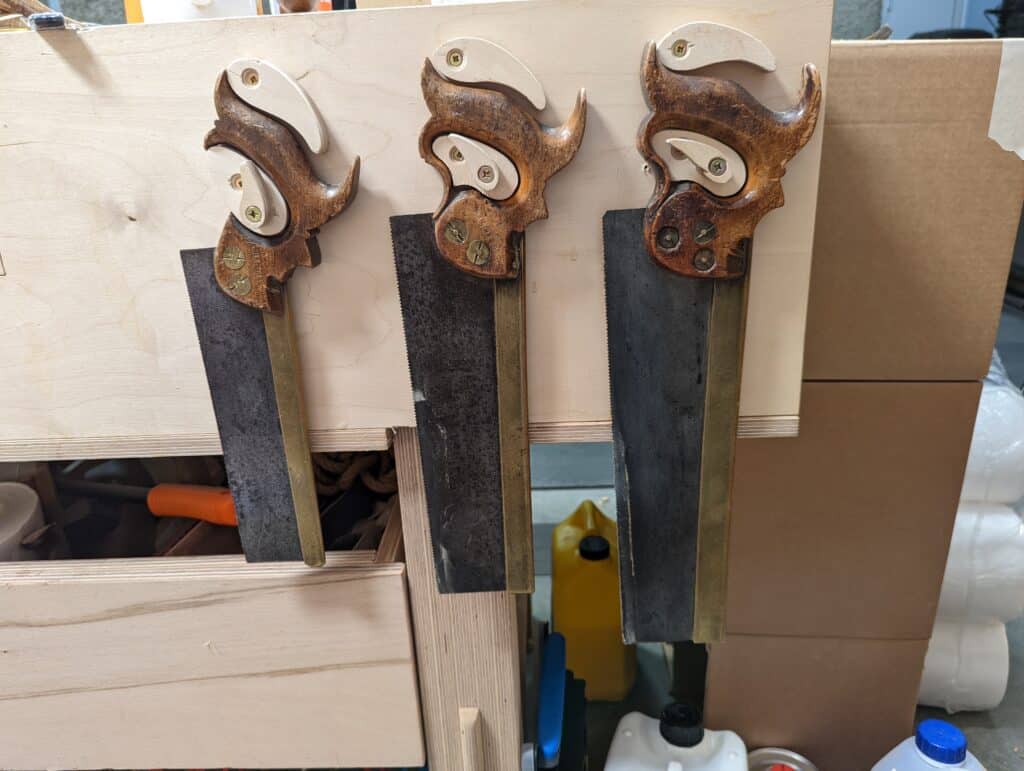
I use three tenon saws, ten-, twelve- and fourteen-inch, sand one Gent’s saw in my day-to-day work. Of the four, the Gent’s saw gets used the most. I use it for dovetailing and small work such as smaller tenons and crosscutting smaller sections of wood. the larger versions are mostly for cutting tenons alone.
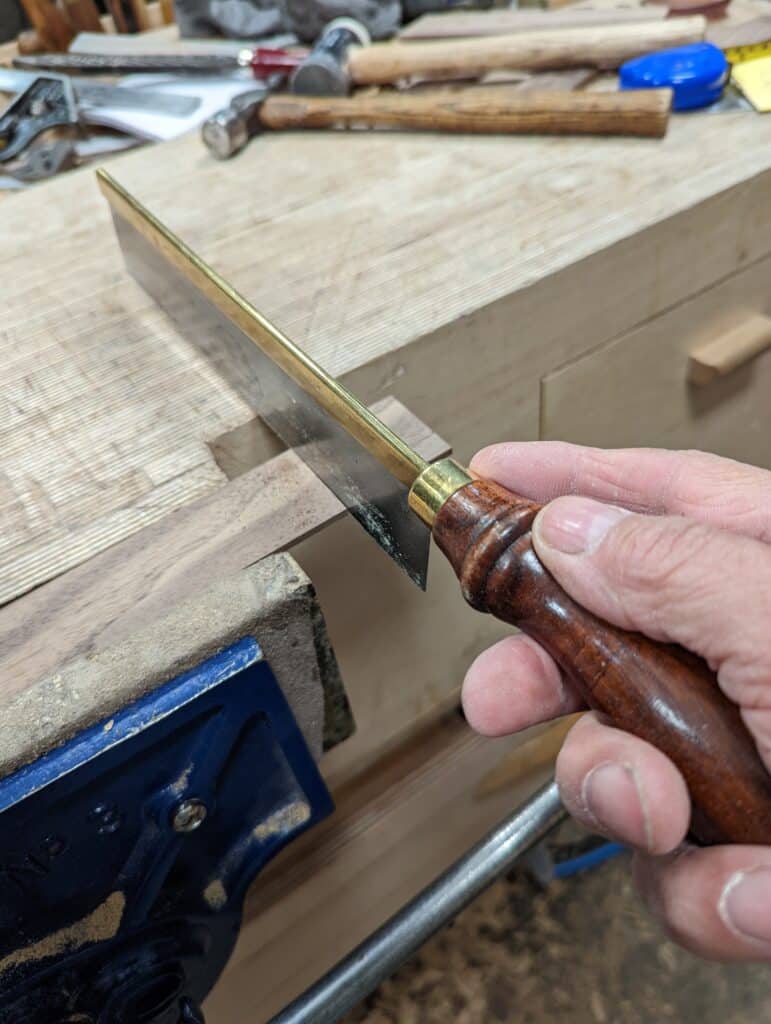
Coping Saw
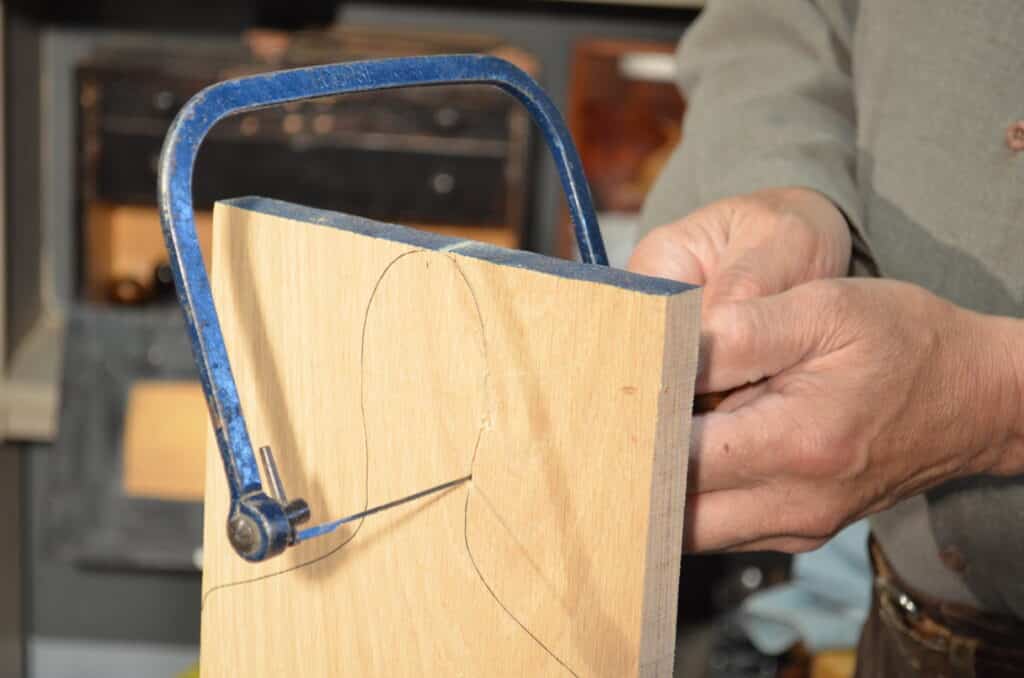
The coping saw copes with all things curved in cuts. Simple and effective and best used with the blade turned so it cuts on the push stroke and never the pull.


“If I succeed in distance training you, and of course I do, then I have succeeded in my original intent…”
You have succeeded with me! I live in Tirana, Albania. I have build my workbench, your workbench really, and many many pieces with the tools you mention here and in the book – I sell most of what I make. Unfortunately, I may be the only one in my city or country still making only by hand.
Your teaching method is very clear, effective and pleasant I should say! There are some videos I rewatch now and then, because they are beatuiful and meaningful!
Forever greatful,
Ermir
Dear Paul,
Thank you so much for, well, everything! I got into woodworking and found your free lessons invaluable. Every time I come across a problem, I search for “(example problem) Paul sellers” and the computer directs me to one of your videos where you have solved that problem, in the most elegant uncomplicated way. Any one can use a specialised tool to achieve a goal, but it takes a genius to solve problems with minimal tools. Thank you for your sincerity to the craft, and thank you for your great lessons!
Very inspiring and encouraging, thank you.
A wonderful collection of tools and instruments. Good to see it, especially as it includes a number that I value. It gives me extra confidence that my set is similar to the master’s. I liked seeing the electronic callipers; although new-fangled, even the cheap ones can give very good results.
Yes, I have tested mine against premium makes using identical positioning on resistant materials like metals and hard plastics and found no difference when starting zeroed out. That used not to be the case but they just keep improving.
A chance meeting at a woodworking show changed the way I pursued my woodworking hobby. I was looking for a top of the line dovetail jig to make router made dovetails. I sat down to watch you make hand made dovetails in much
less time than it took to set up the mechanical one. It made me stop, think and realize that I didn’t need a power tool for every task. Don’t get me wrong, I still use power tools but now I’m much more efficient and enjoy the work I do with hand tools.
Hi Paul, I have followed your restoration and innovation with these budget saws and vintage planes and rarely use any premium tools that I own, they are my go to tools and prefer them to anything. Would you mind telling my the tpi on the three saws on your bench as a good reference point, I take it they are all filed for rip cut? Kind regards Phil
The Spear & Jackson 22″ panel saw is 10PPI, their 24″ is 7PPI and their new 26″ is 6PPI.
Hi Paul,
Do the DVD’s cover the same material, just different format?
If so prefer to have just book… vet on disability need to save my shillings!
Also please do a video about building your blue shop stool.
Stay well and God Bless!
Jeff
Canada
I think we created the DVDs because many people like to have them next to their work without searching online for parallelity. Most of everything is available elsewhere and especially on our commonwoodworking.com site.
Over the years I have accumulated all of these tools however for combination squares I will only own Starrett or Mitutoyo. I have had several Stanley combo squares and not one of them was accurate. The Starrett and Mitutoyo on the other hand, are dead on square. One is 70yrs old and still bang on. Stanley offers cheaper alternatives than these but are rarely accurate. I have other Stanley tools that have survived the years and this is the only tool out of the line that has let me down. Oddly when I used as Starrett blade in the Stanley square is became accurate.
But there are other excellent and superbly accurate makers too, everyone. Secondhand you can go for Browne and Sharpe, Chesterman, Rabone Chesterman and others. Also, I own about twelve of the Stanley 0-46-151 combination squares which I had for my classes in the school and they all tested out square with the Browne and Sharpe, Rabone Chesterman and the starrett versions just fine. This one costs £26 and has a cast iron head and not the cheaper alloy ones Stanley also sells which may start out square but often go out of square because of the flimsy alloy. I say this because a Starrett will be prohibitive for the majority as the cost is around £140.00 here in the UK. I just bought a very nice Rabone Chesterman for £25 on eBay and that’s a good route to go. I just hate for anyone to feel they have to go out and spend so much especially of starting out.
I splurged on a pair of Starrett outside spring calipers for turning because the cheap one I had was not holding its setting when turning down to diameter. The Starretts came out of the box with the jaws in twist and out of plane. They had no interest in remedying this other than having me pay shipping to send them in for repair under warranty. My application was woodturning, not precision metal work, so I manhandled them into passable fettle, but am constantly double checking them because I don’t trust them. I’m not sure that price correlates with quality in any predictable fashion.
“The coping saw is best used with the blade turned so it cuts on the push stroke and never the pull.”
Why?
Much more power, greater accuracy, fractures on the outcut where the wood goes against the wall and the most seen face is crisp and neat, easier to use. I could go on. People treat a coping saw like a fret saw, not at all one and the same. Just give it a shot next time you do an internal corner coped cut. You might be surprised. I never use the pullstroke, ever!
Elsewhere I have seen coping , fret and piercing saws spoken about as though they are the same.
Hi Paul,
I just wanted to say thank you for sharing all the information on saws and saw sharpening. I bought the 10 PPI S&J, which works wonderfully.
I also purchased an old saw to practice sharpening on, which had teeth missing and was in a sorry state. Following your videos, I filed them off and retoothed it to 6 TPI and now it works great! I’ve never seen a saw do rip cuts so fast and easily, and the sawn surface leaves are not too rough either.
I had to joint the tops a couple of times to get the teeth even, but for a first attempt, I’m really pleased.
I’ll still use disposable for rough work like chipboard and plastic as I think the hardpoint teeth are better suited, but otherwise, I’m sticking with resharpenable now. Much better for the environment.
I’d like to solve a problem with my saws. I bought and had shipped to my location off shore, two Disson 24inch saws. One for cross cut and the other larger tooth for ripping. As I learned to saw straight I realize that these two saws are bowed. I know they are spring steel but they do not return to straight. So I only rely on the back half of the saw to cut straight. Using the entire leangth starts to depart from the line quickly. Paul, do I simply replace these, or is there some way to correct them? The bow is by about 1 centimeter from handle to tip.
And have you tried bending them the opposite way? Sometimes it takes a hard bend to correct it but if it is just a bend it will bend out.
On the first day of the intensive class, you said two things. First, the class would change our lives. Second, woodworking involved learning to deal with risk. You were right about both and am deeply grateful for the opportunity to have studied with you then and, following on, virtually.
Two comments about the tool list. First, just in case someone new to your teaching just happens to land on this blog post, that person should look for earlier posts describing the 10 essential tools. One can build a lot with just a subset of what is shown here and even a subset of the 10, just to get started.
Regarding calipers, my digital calipers sit on the shelf with a dead battery. On the other hand, a (mechanical) dial caliper with fractional scale never leaves my bench top. See, Shop Fox D3208 Fractional Dial Caliper. The key thing here is that digital calipers, when set to fractional mode, give useless readings in 1/128th of an inch that one must juggle mentally into what is desired, like nearest 16th or 32nd or even 8th. Look at the photo of the D3208. When you have a reading on the scale, you can simply _see_ the closest 16th, 32nd, or 8th. It is immediate. If I were a machinist, I’d live in the fractional decimal world and none of this would matter. As a woodworker, somehow I just want to stay with fractions. If I’m making stock for a 7/16 thick moulding and pick up calipers to monitor thickness while milling / planing to thickness, I don’t want to juggle decimals when using the calipers. The D3208 (or anything similar) really shines.
Aside: Please, no lectures about metric. I am (was) a physicist. I spent every day using every imaginable unit.
I’ve added quite a few tools beyond this list and am very glad to have them. One is your “round in both directions” plane. Beyond its intended purpose, It is excellent for getting a quick peek at color / grain on rough lumber.
One of my biggest tool regrets is buying used chisels when starting out. Too many of them were just too abused and too much work to fix, especially as a new woodworker. I also bought quite a number of saws that were beyond my ability to save at the time (and some, still so).
Just a quicky, have yet to read this blog. But don’t you mean £3 10 shillings 👴
Best wishes Geoff Maddison
Nah.. You mean 69 and 11 pence three farthings!
Hi Paul, great blog once again, my favourite tool is the Stanley #4 plane, it’s my third hand and your right nobody has come close to a design to beat it. There’s just one item that I think you have missed off your list and maybe it should have been the first on the list. I believe the diamond sharpening stones are a vital item, you can have an arsenal of tools in your workshop but they useless if there are not razor sharp. You were the one that pointed me in the direction of diamond stone sharpening, before that I had always used oil stones and managed but not the perfect solution. But after using the diamond stones my life as a wood worker became so much easier and satisfying. Keep up the fantastic teachings you do for so many people, it’s truly a fascinating journey.
Sharpening stones are not tools, Paul, in the same way, the vise and workbench are not tools. Clamps, pencil sharpeners and many more items in the workshop are not tools per se. You may not realise but my work with diamond plates 25 years ago started the ball rolling to make the plates famous when 95% of woodworkers were all advocating and using Japanese water stones. It took me 25 years to help people adopt them. At that time no one was using diamond plates.
Yes Paul your right. Sharpening stones are not tools, misguided mistake. But what a difference they make in every day woodworking, I’m glad you steered me in to using them years ago.
Thanks Paul. Having found you and followed your training since 2015, I can say that I completely agree with your advice. Should someone want to buy a more premium tool, they can, but it won’t give a better result.
Speaking of books, I know you have been working on some booklets of some of your popular designs such as one of the rocking chairs. Any idea when that might be available for purchase?
In related matters, my favorite hand plane is a rebranded manufacturer’s sold as a Craftsman No. 4 sized hand plane. I bought it like new in 2017 or so for $25. It really does work as well as my Lie Nielsen hand plane. I would never ever replace the blade that came on that No. 4 as it works perfectly and is in fact easier to sharpen than my Lie Nielsen A2 steel blade. I have no intention to sell my premium tools but they are not at all necessary. I have started to collect various tools sold under the Craftsman brand and plan to build a jointers chest to house them. Plan to build some major projects only using these tools.
Have Paul, I was asking what tpi are the three tenon saws at your bench, ( the 10,12 and 14 inch)I have already converted the hand and panel saws, I’m interested basically in this because it obviously gets you through most of your bench work
Kind regards Phil
My 10″ is 14PPI and my 12 and 14″ are both 10PPI.My Gent’s is 17PPI
I can only Thank You Mr. Sellers and extend it to your team.
Since my path crossed your online school, I’ve been making furniture and small items for my home, and my family and friends also had some costume orders too from strangers.
Thank YOU!
I’ve been a follower for several years. You are a true lider, an inspiration!
Regarding the files, can the same file be used for metal and wood, or it’s important to have both?
And when it is used on wood, can it be dragged back, to return to the starting position? Or is it better to lift it from wood with each returnig stroke?
I try to keep mine separate, but not always. But I do use separate, sharp, ones for brass.
I have a couple of compasses but like the idea of one with a winder adjustment – in the UK B&Q do one at the bargain price of £5.47. Picked one up from the local store this afternoon.
Don’t hate me…I bought the aluminum winding sticks! Kept effing up the winding stick project and ruining red oak. My wife calls it the whining sticks project.
Thank you Paul for this extensive list. Of all of those in the list, my favorite has to be your router plane. I purchased the kit you offer and in anticipation of its arrival I purchased a piece of walnut to make the pieces. I had everything ready for the day the kit arrived, only requiring drilling of the holes for the hanger bolts and cutting the groove for the cutter. Final shaping of the base will be done shortly but I have tested it briefly and it works exceptionally well. I do want to mention to any who have ordered the kit but not received it. The blade comes in a plastic container with a label indicating a sharp blade inside. Believe the label. I have never received any edged blade direct from the manufacturer as sharp as this blade. I had it on the bench and accidentally bumped the cutting edge with the side of my finger. Fortunately bandages are always present on my bench.
Thank you for all that you share with the woodworking world.
With the popularity of the pre 70’s design of Stanley-Bailey hand planes, I sometimes wonder why they don’t go back to making them the same way that they did back then. It seems like it would be a winner for them. Recently, I have had trouble finding reasonably priced replacement parts for some of my older planes, and I can’t help but think that if Stanley still offered quality made parts for their older models, that they would probably sell well.
Hi Paul,
Just curious – when you plane a board 4 square, what is an example of the different thicknesses at each corner when measured with the calipers? (Ie what is the tolerances across a board if that makes sense, for someone who knows what they are doing?)
Many thanks,
I’ve been using MHG chisels for several years and find them excellent, although I’m not overfond of the handles, having become used to English patterns over the years.
Hi Paul – forgot to ask what is the ppi on your gent’s saw?
Many thanks for your posts., and best rgds – Frank
The one I use most is 17PPI, that’s the Crown one. I have a short 6″ one I cut new teeth into at 32PPI and then I have the Zona gents saw they used to call their modellers saw but now call their Universal saw for some weird reason. The one I have has 32TPI.
Many thanks Paul. And for the many innovations – to me – that have enhanced my woodworking – the handled cabinet scraper, the router tenoning technique and many others. My main guide in the 1970s/80s was Charles Hayward, but your advice and experience have been priceless.
Paul
I saw your video on the bandsaw and wondered how that fits in with your woodworking?
I’m not sure what the question is, John?
Most of your posts and videos are about hand tools. Do you use the bandsaw? If so, for what kind of tasks? I have thought about adding a bandsaw to my shop for resawing and cutting curves. But I have hesitated because I’m trying to reduce my dependence on power tools and find other ways to accomplish the same task.
Ah! Got it! I recommend the bandsaw as the best all-rounder machine for hand toolists to include in their workshop because it is so versatile, takes such a small footprint and saves so much of the donkey work for resizing wood. It’s the only machine I have or want in my garage workshop and when properly set up it will resaw up to and over 10″ of most any hardwood I want and do it to tight tolerances. It would be silly for me to suggest to my audience that they don’t need or shouldn’t use a machine of any kind and generally I would never say that. People use machines for a wide range of good reasons not the least of which are physical limitations, health, space and more. And we should not discount that people are often time-strapped. There are issues surrounding why people advocate using machines as so called power tools and I could argue my corner all day long and most likely win. One good reason is that you may never actually develop any really skilled workmanship, but that horse already left the stable. I don’t care too much if most woodworkers have lost out on life. That is their choice. They could have had both and many do. I have lived in both worlds and made my choice.
Hi Mr Sellers
Will a Stanley 78 perform the work of a shoulder plane?
This is a good question, Ed. The answer is yes and no. These two planes are entirely different animals altogether. I have cleaned up shoulders with a #78 and rebated with a shoulder plane. There are a couple of differences. Shoulders are almost exclusively situated adjacent to the faces of tenons and at 90 degrees both ways. That said, they can be 90 degrees from the face of the tenon but sloped at another angle but still going across the long grain long-axis direction. The low angle, solid mass of the bevel-up shoulder plane offers a solid dynamic because of its more direct centre of thrust. The bevel-down plane as in the #78 is more awkward in the cut.
Paul, this is the best list I’ve seen, and I’ve read a lot of lists of starter sets and most often used tools, and top ten lists in woodworking magazines. One tool I can’t live without is my Stanley adjustable mouth spokeshave, I believe it’s a No. 54. It’s great for rounding over or chamfering edges. They are the best thing ever for shaping chair legs and making guitar necks. I often have two of them on my bench, one set fine for a good finish or difficult grain and the other set wide for hogging off stock to get down to the basic shape quickly. The only problem is they are addictive like hand planes and now I have a collection of 15 spokeshaves of all kinds.